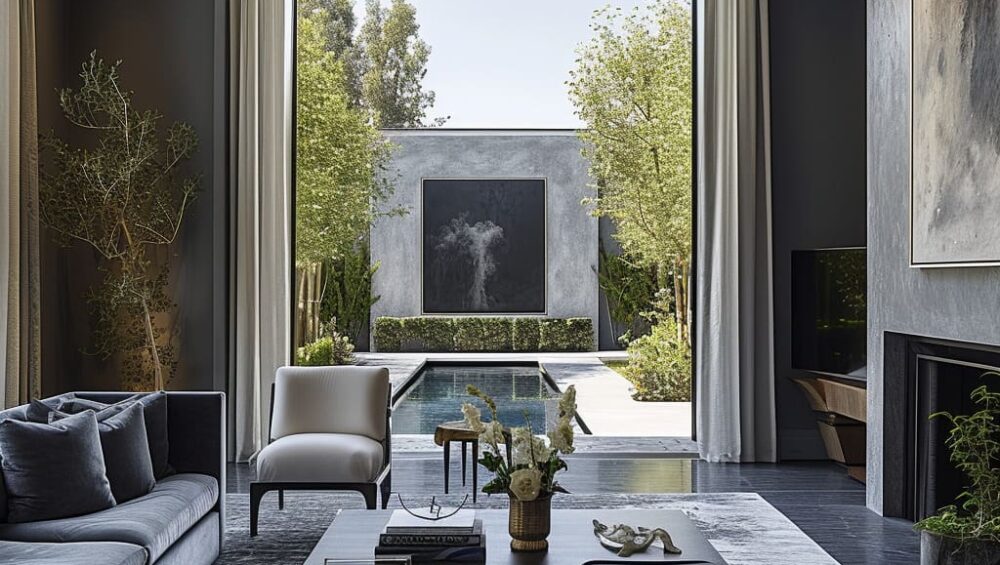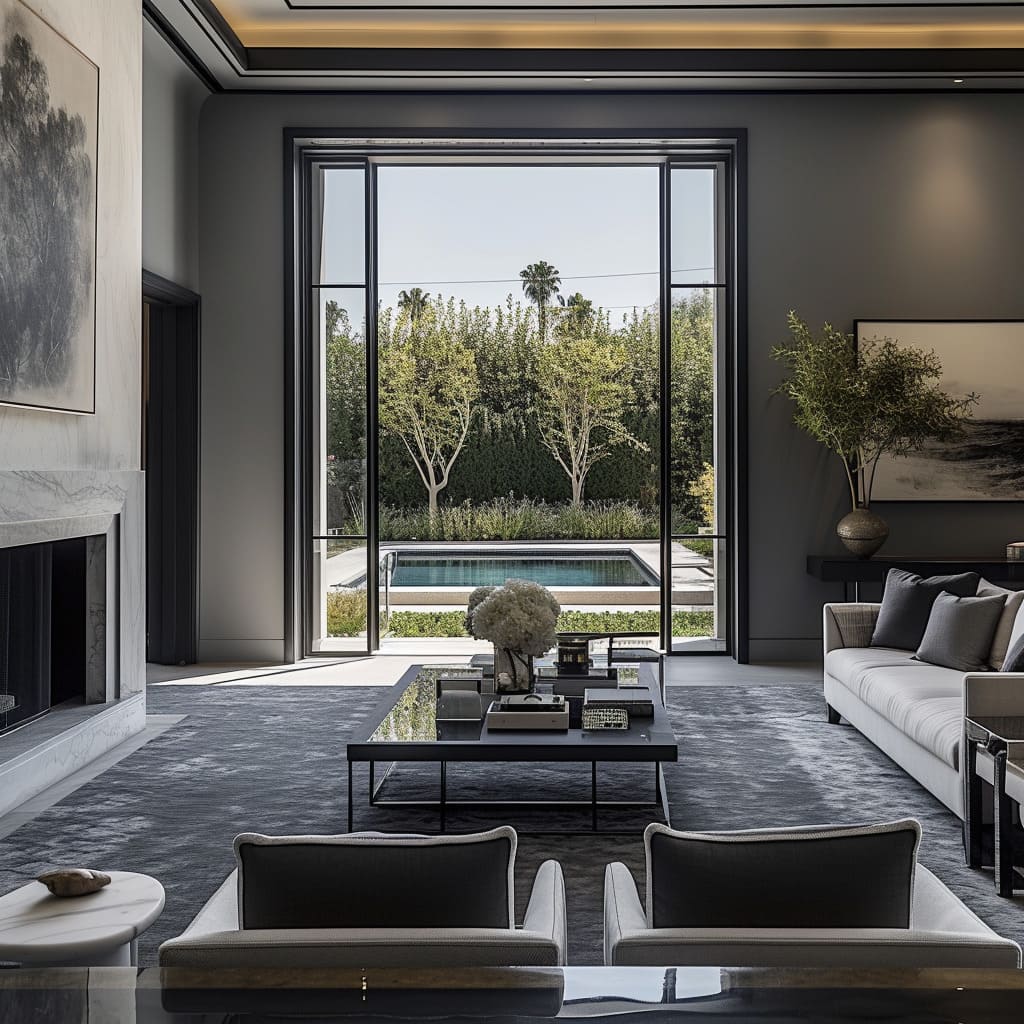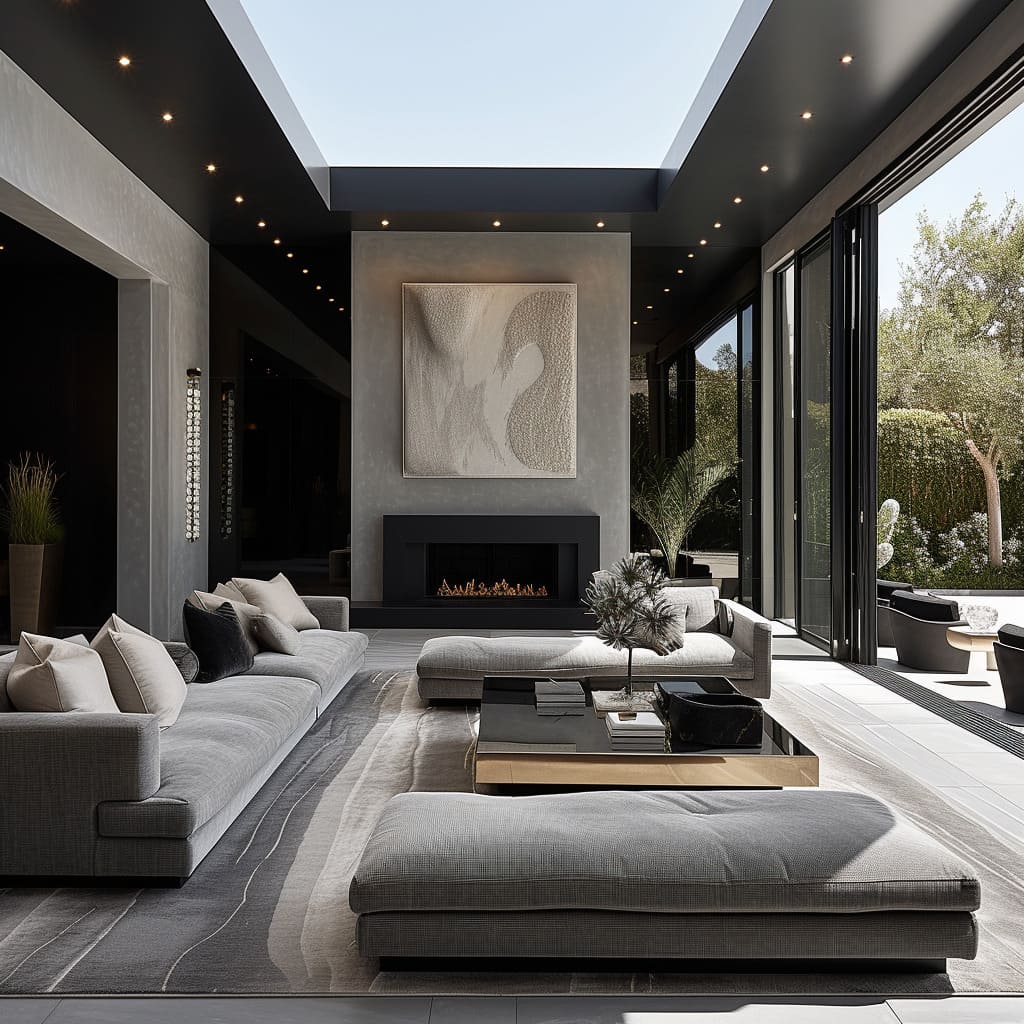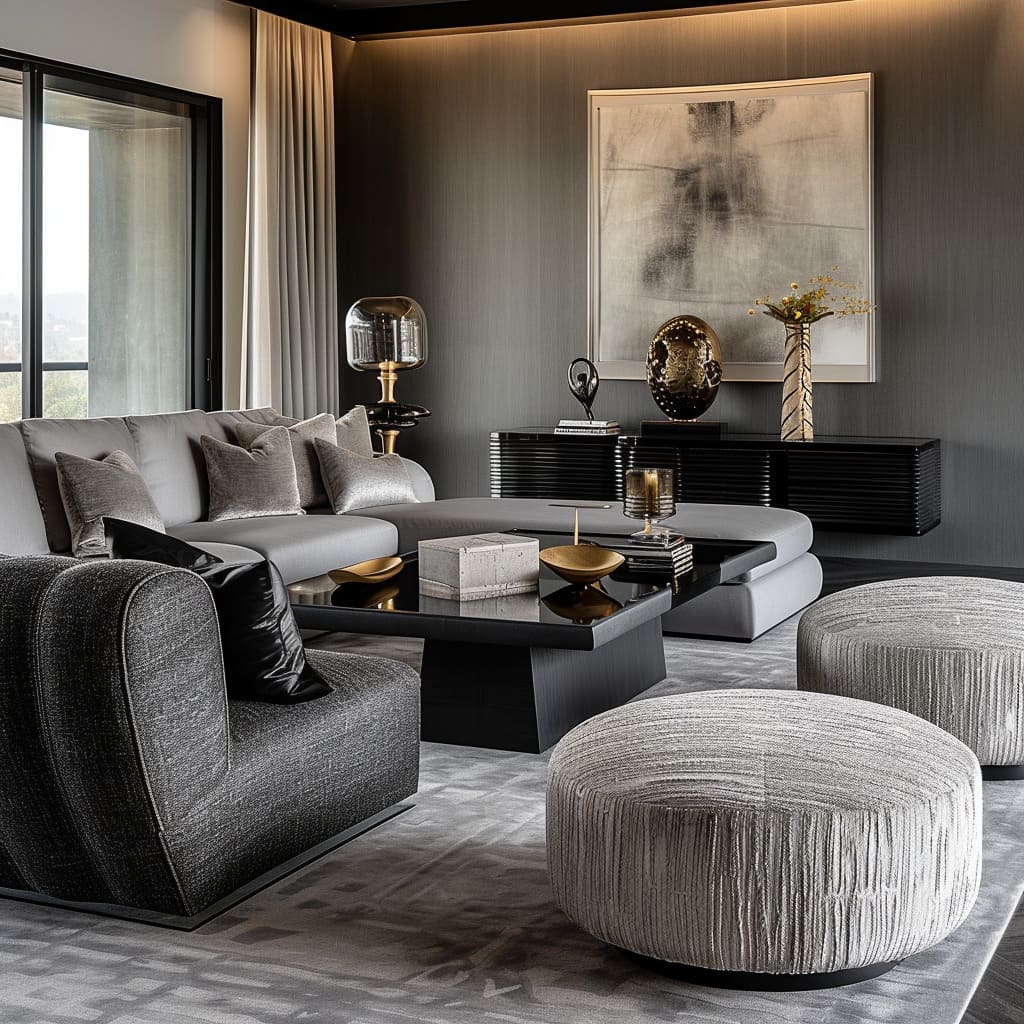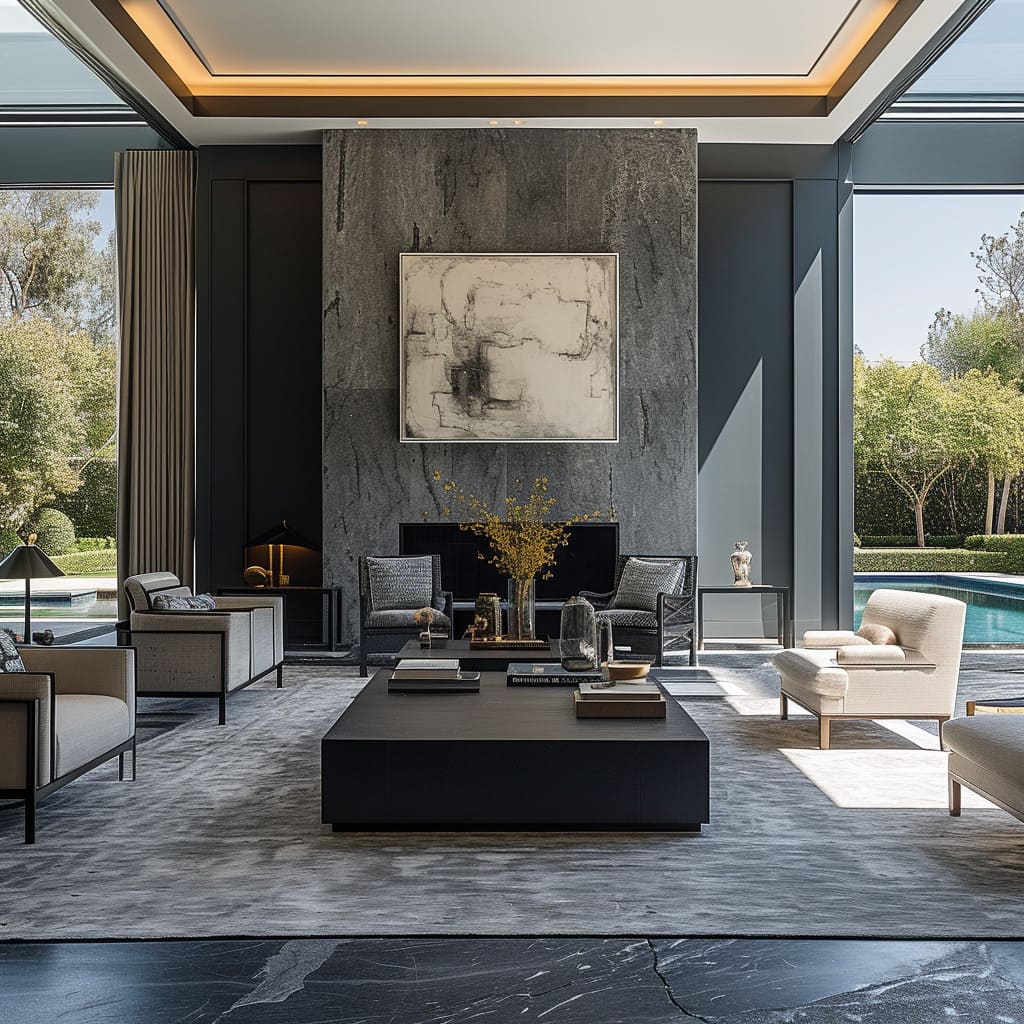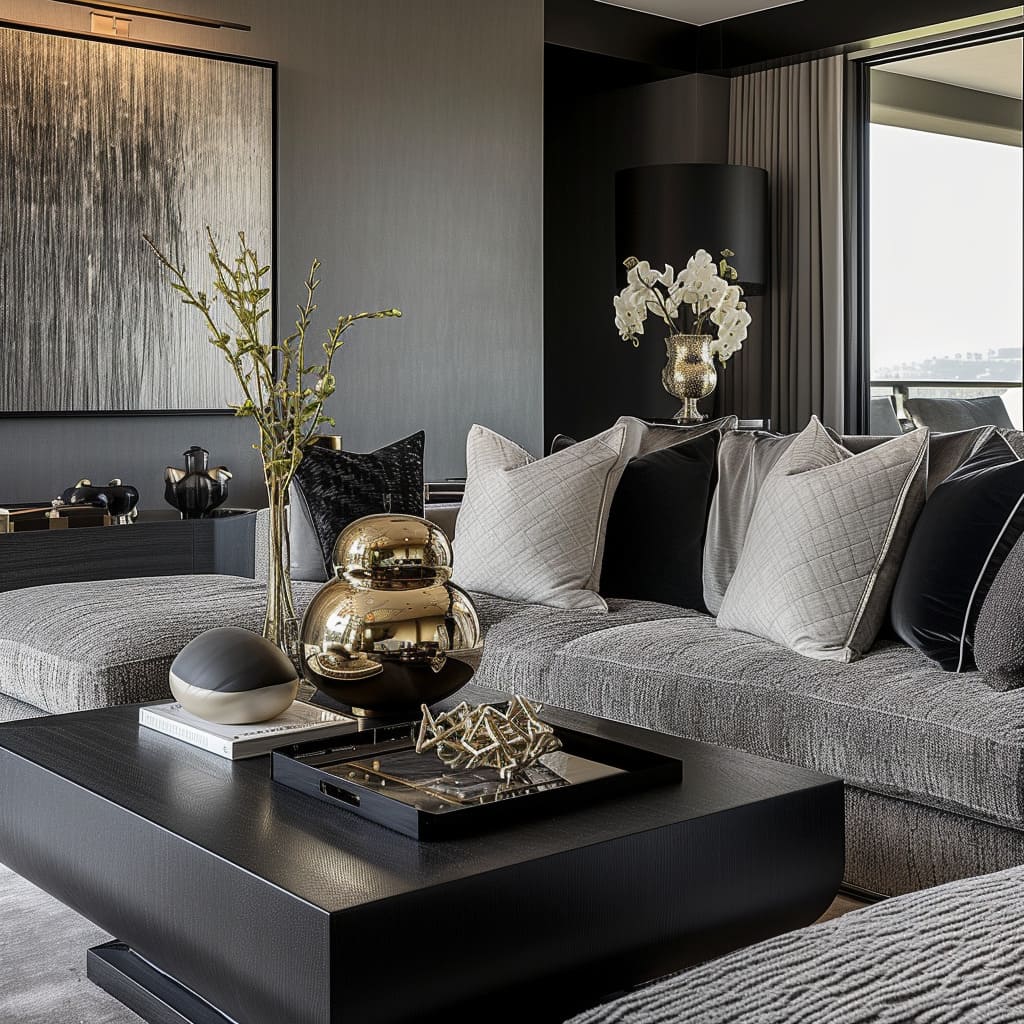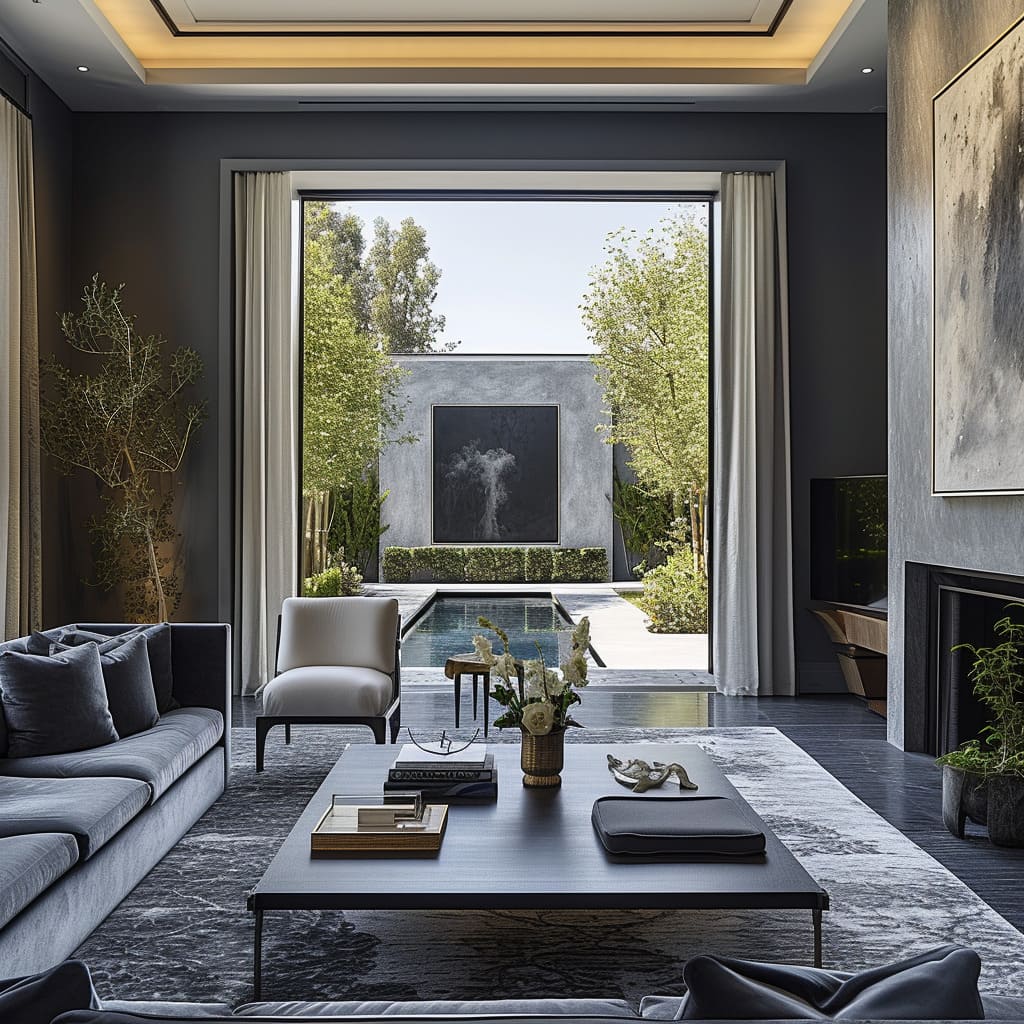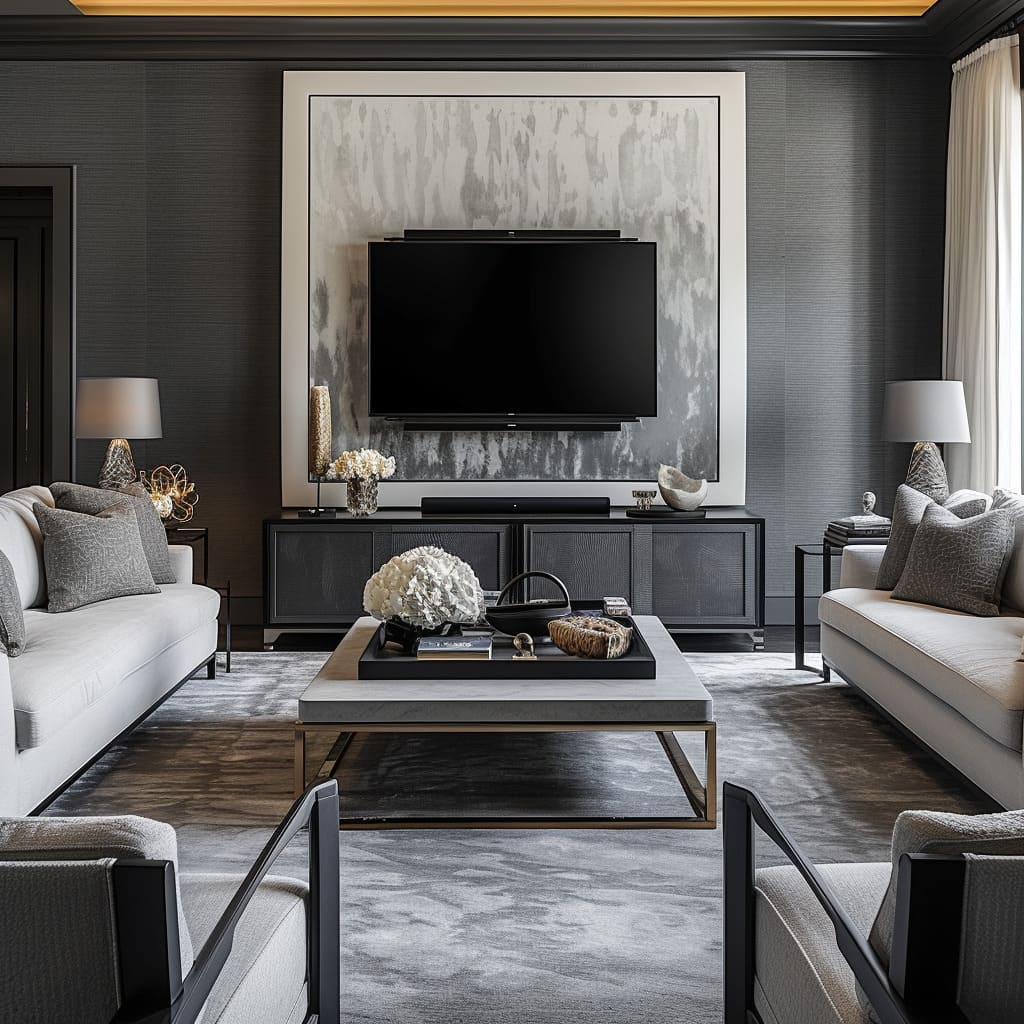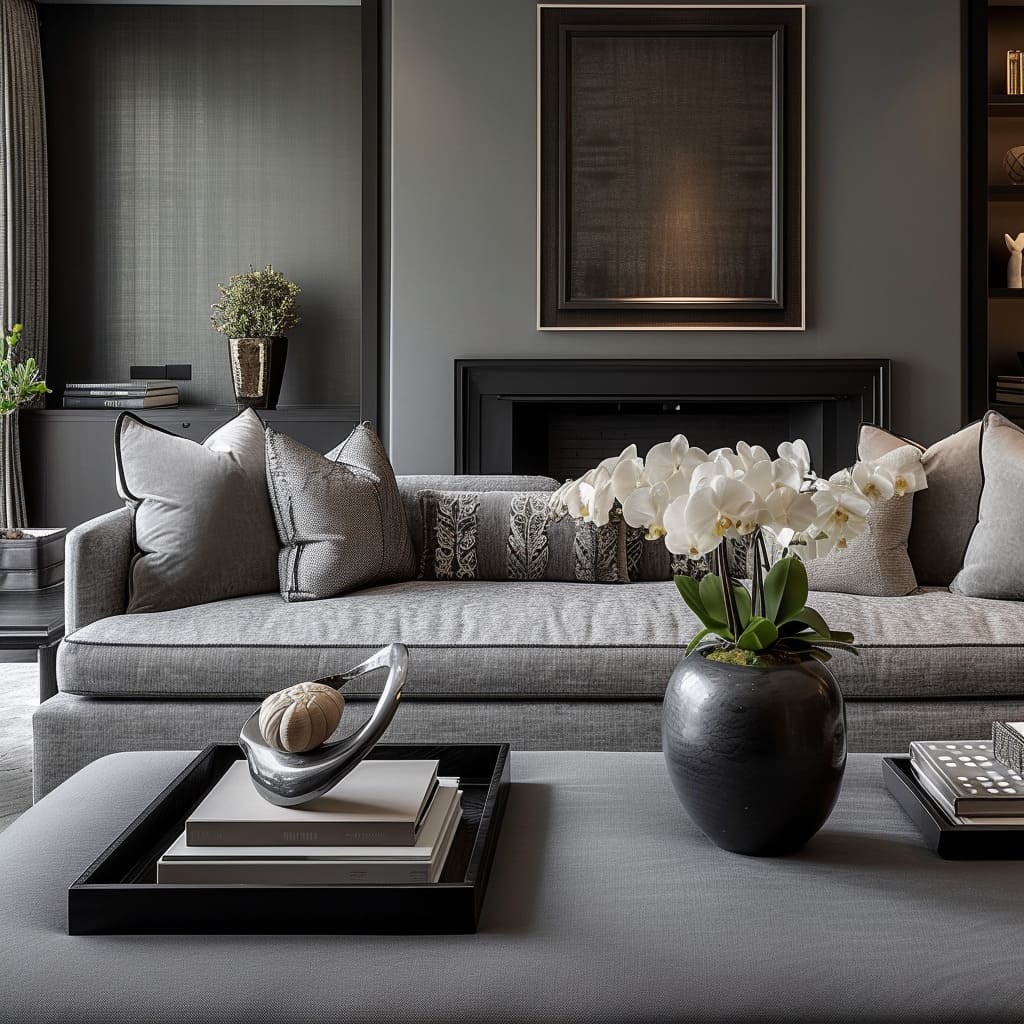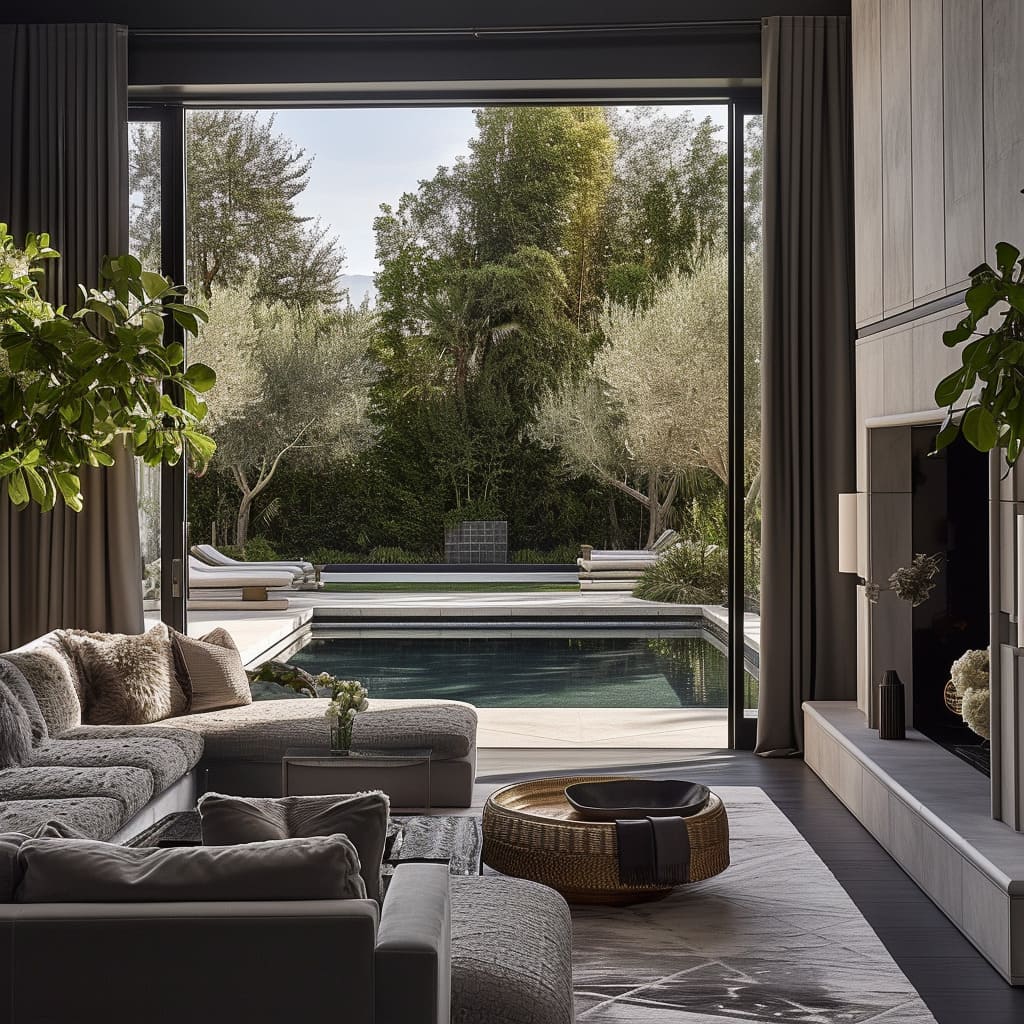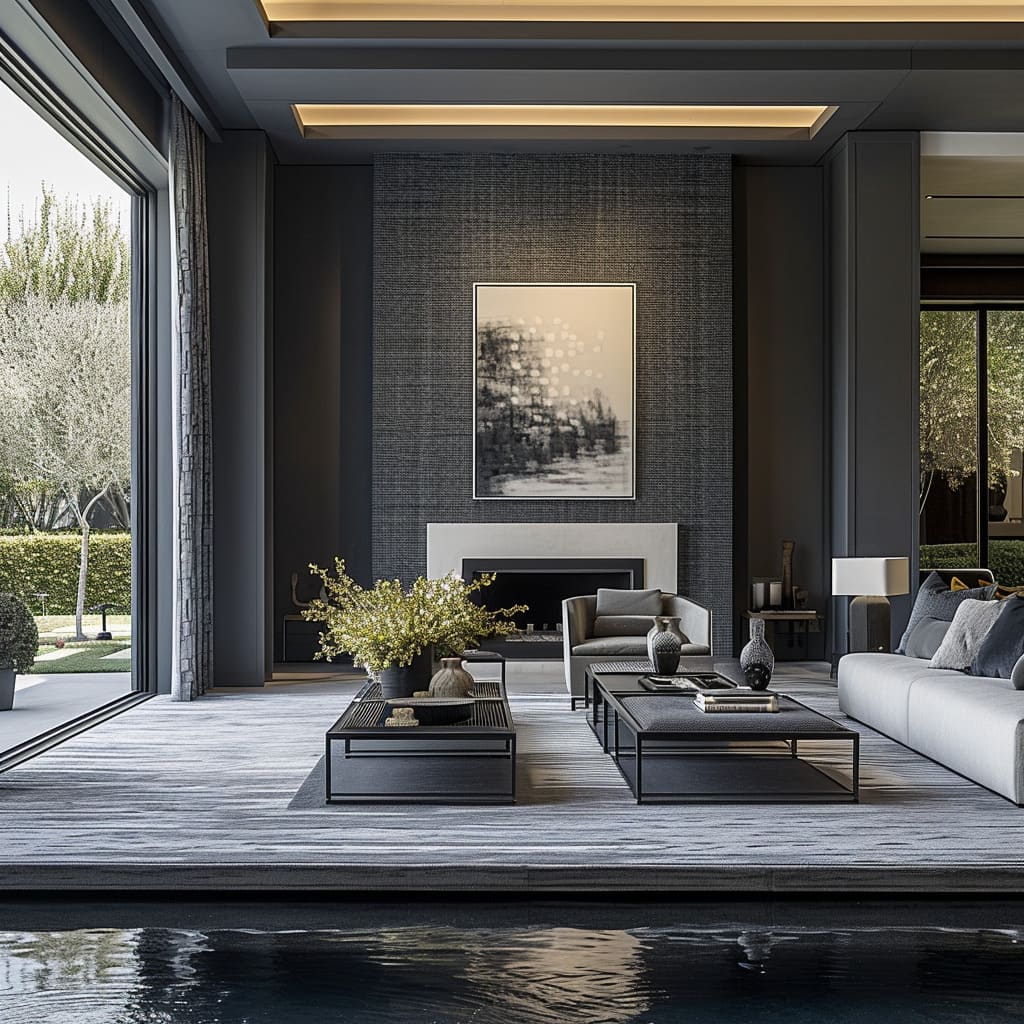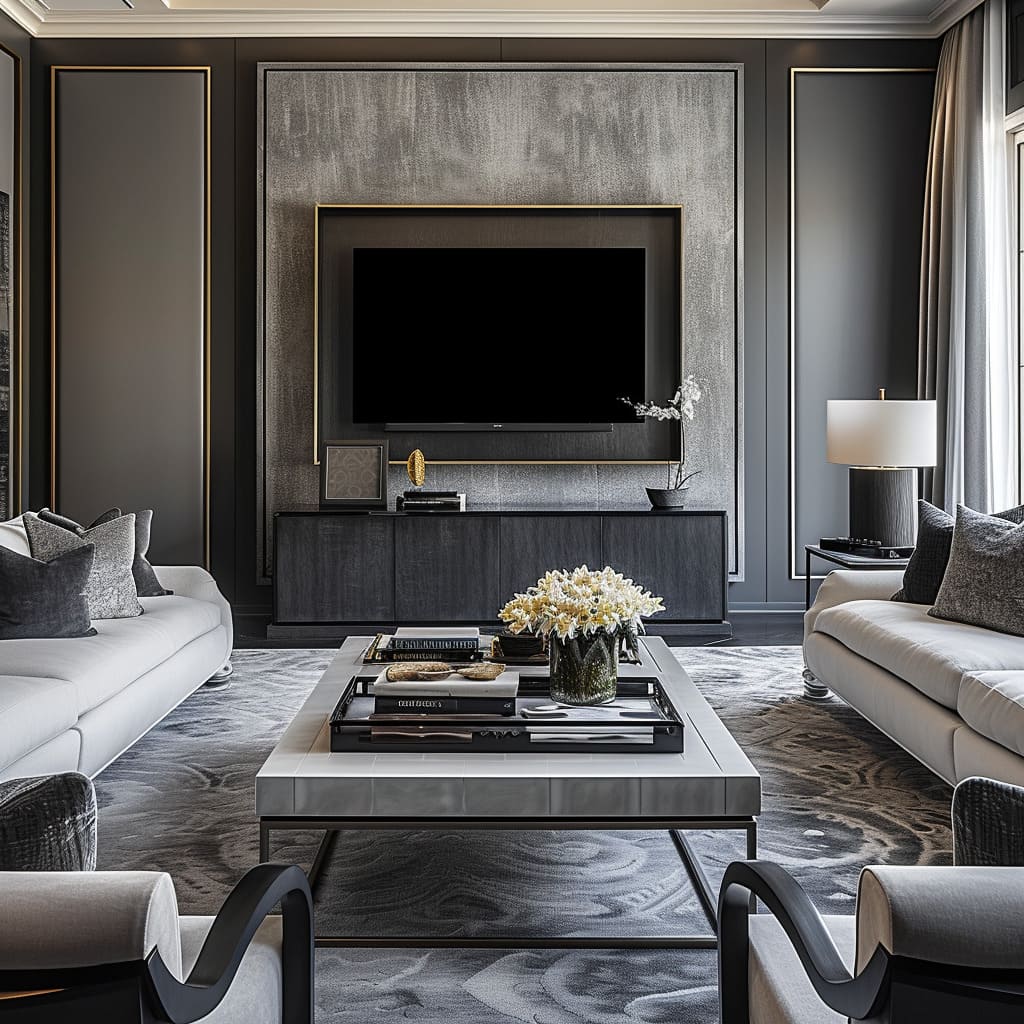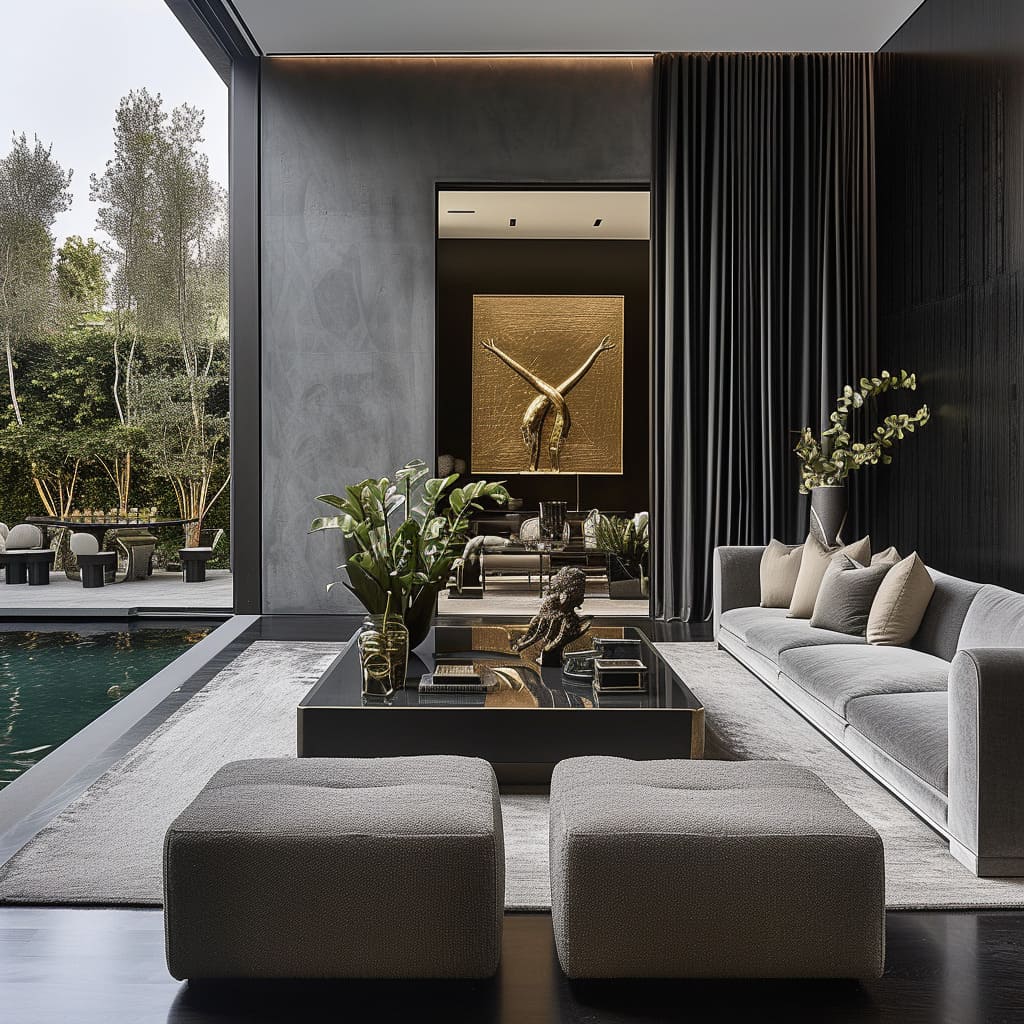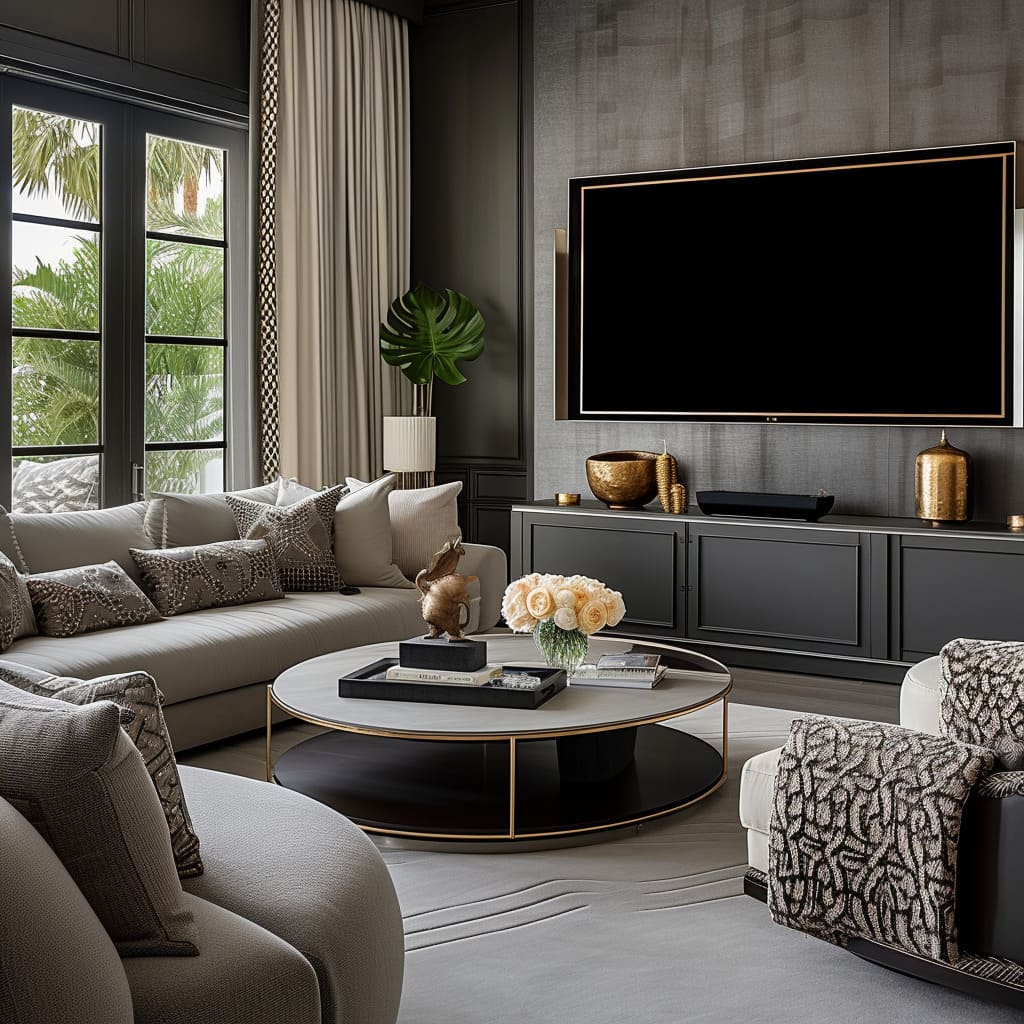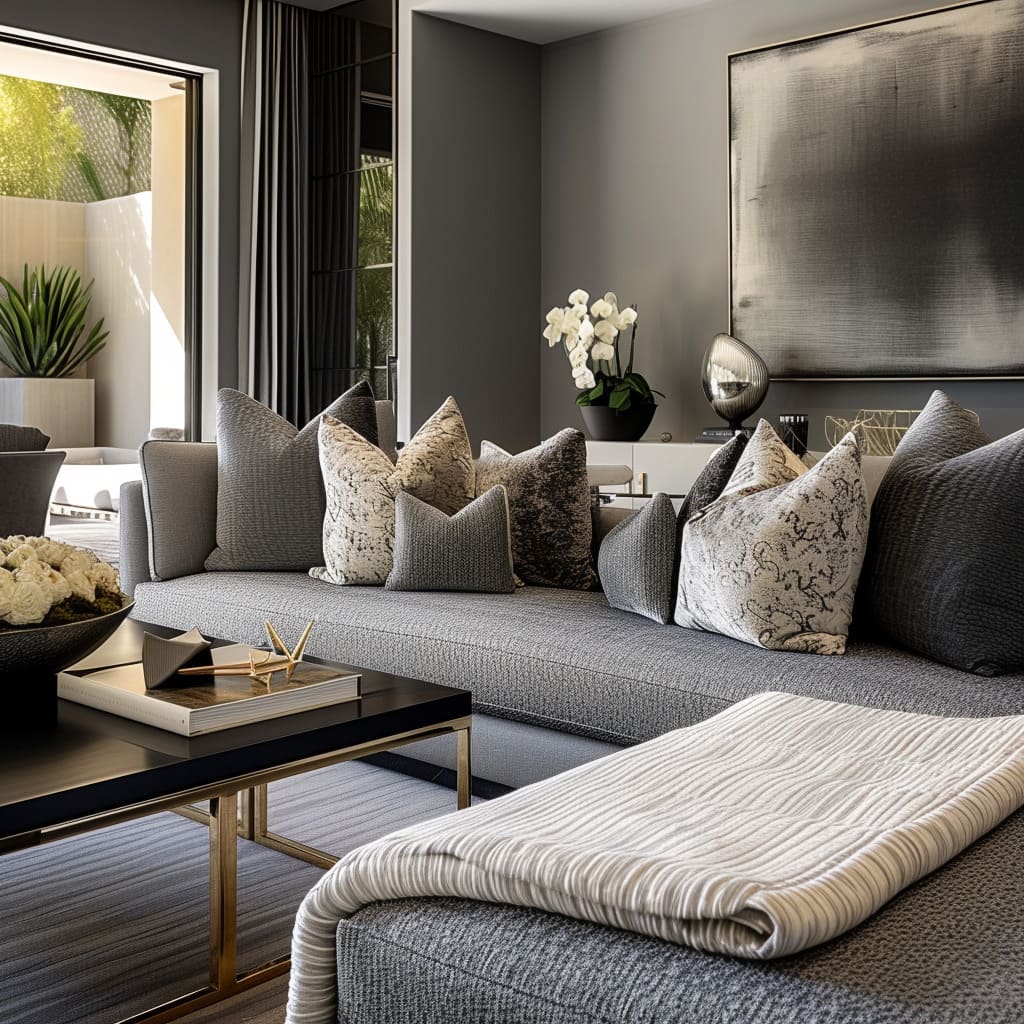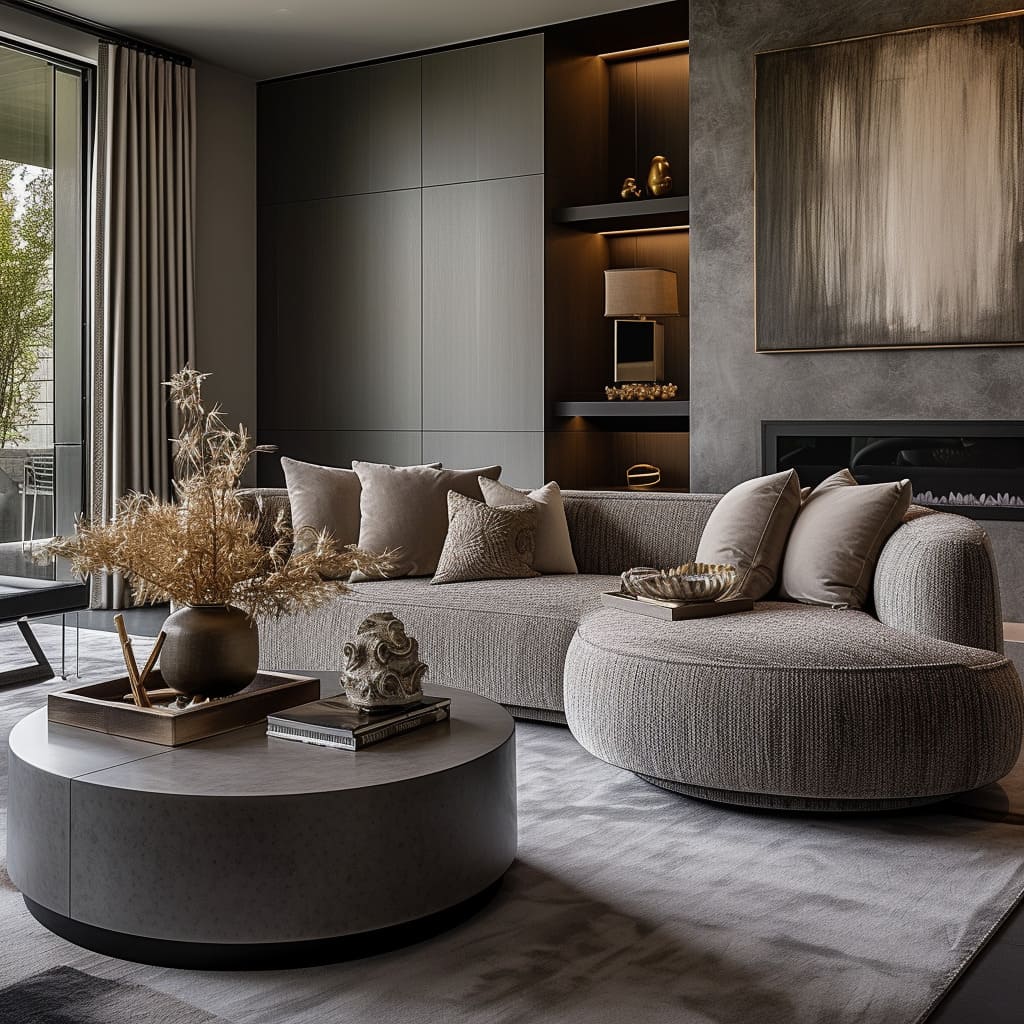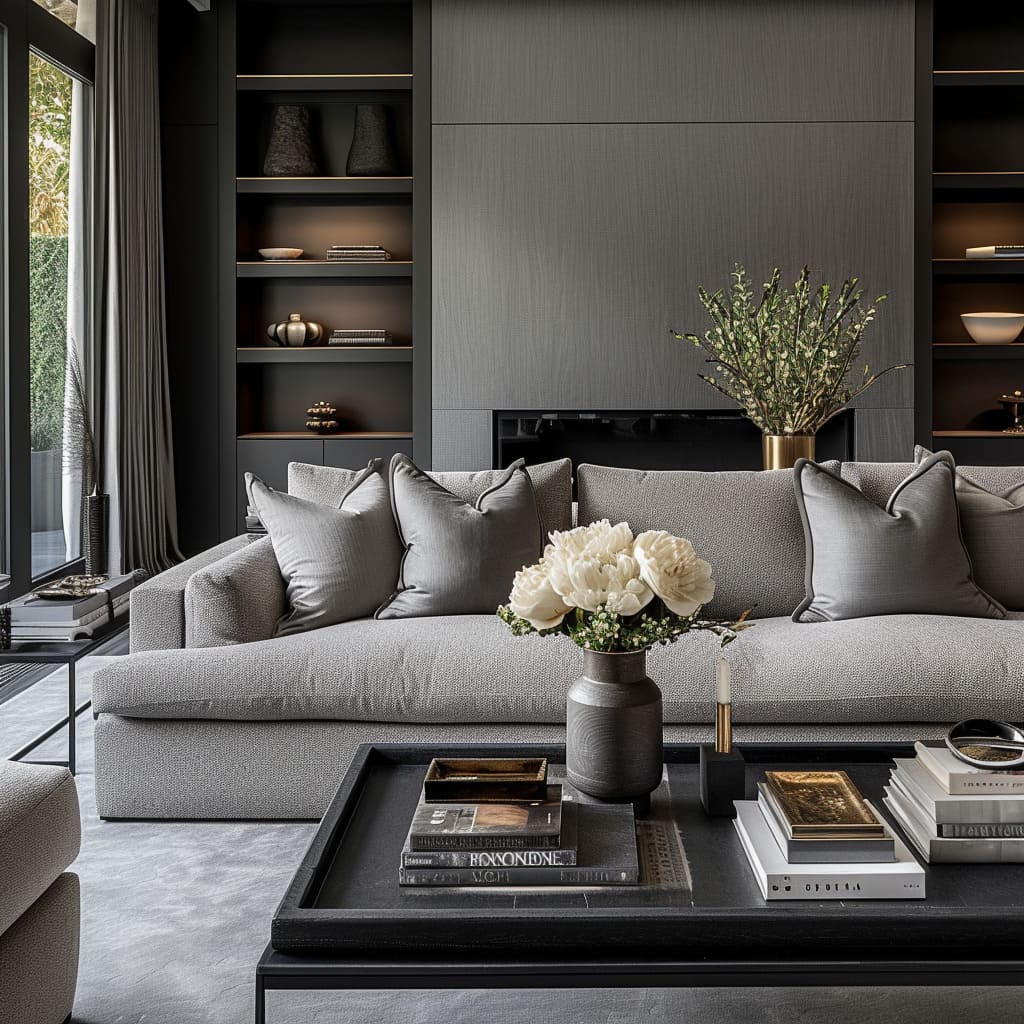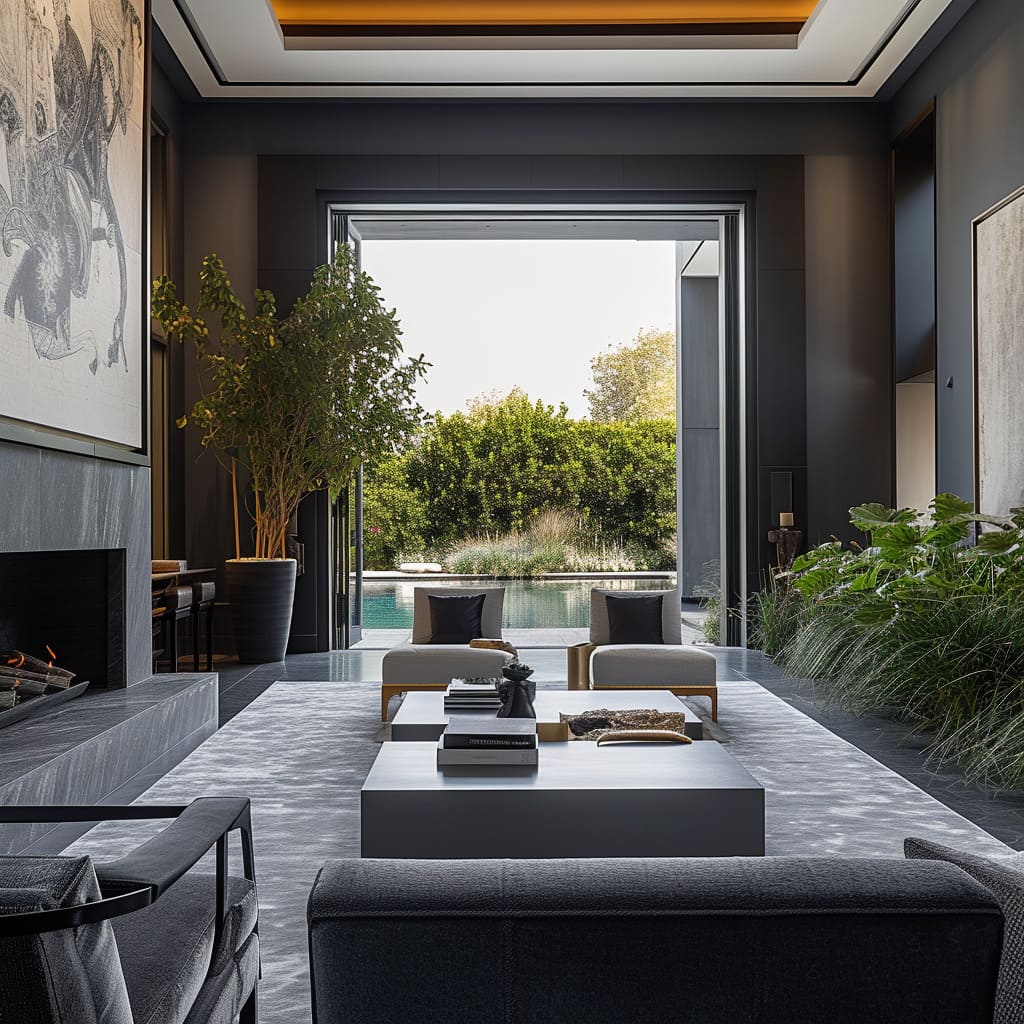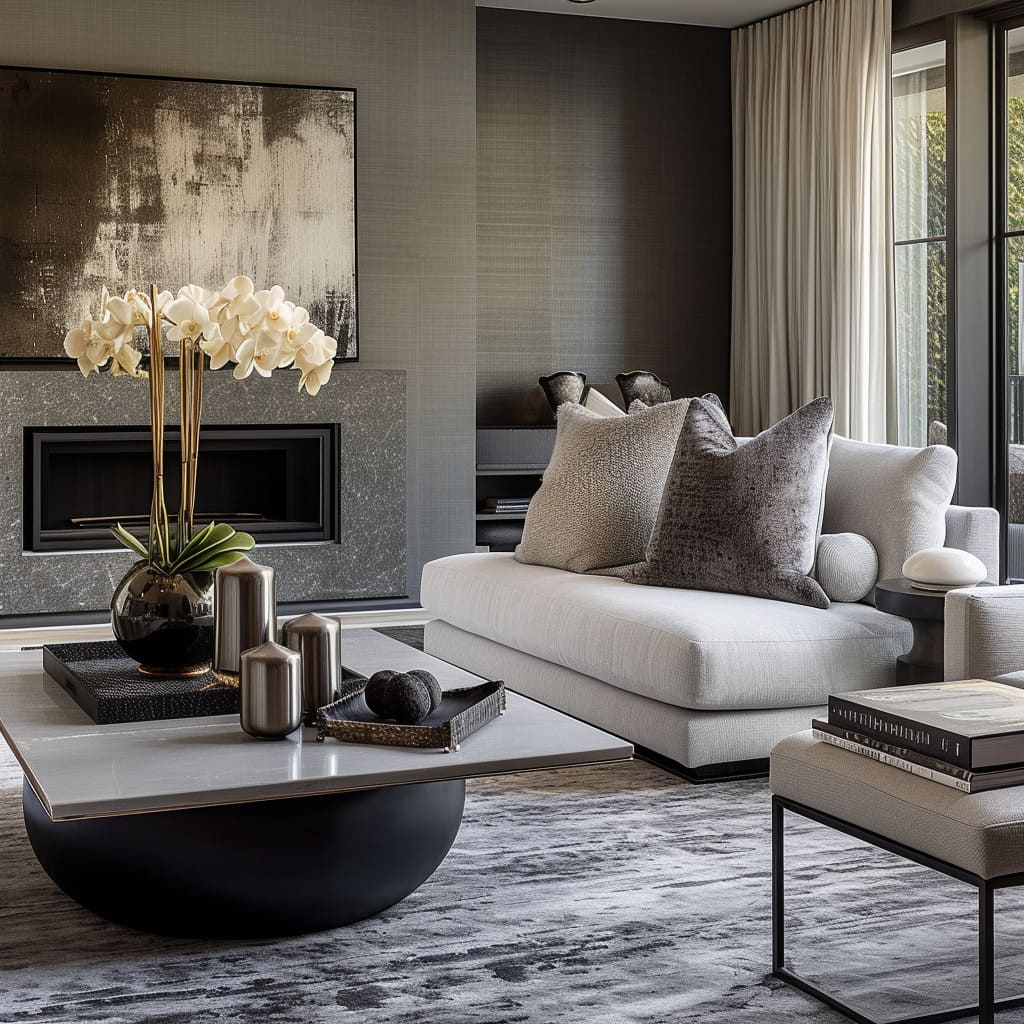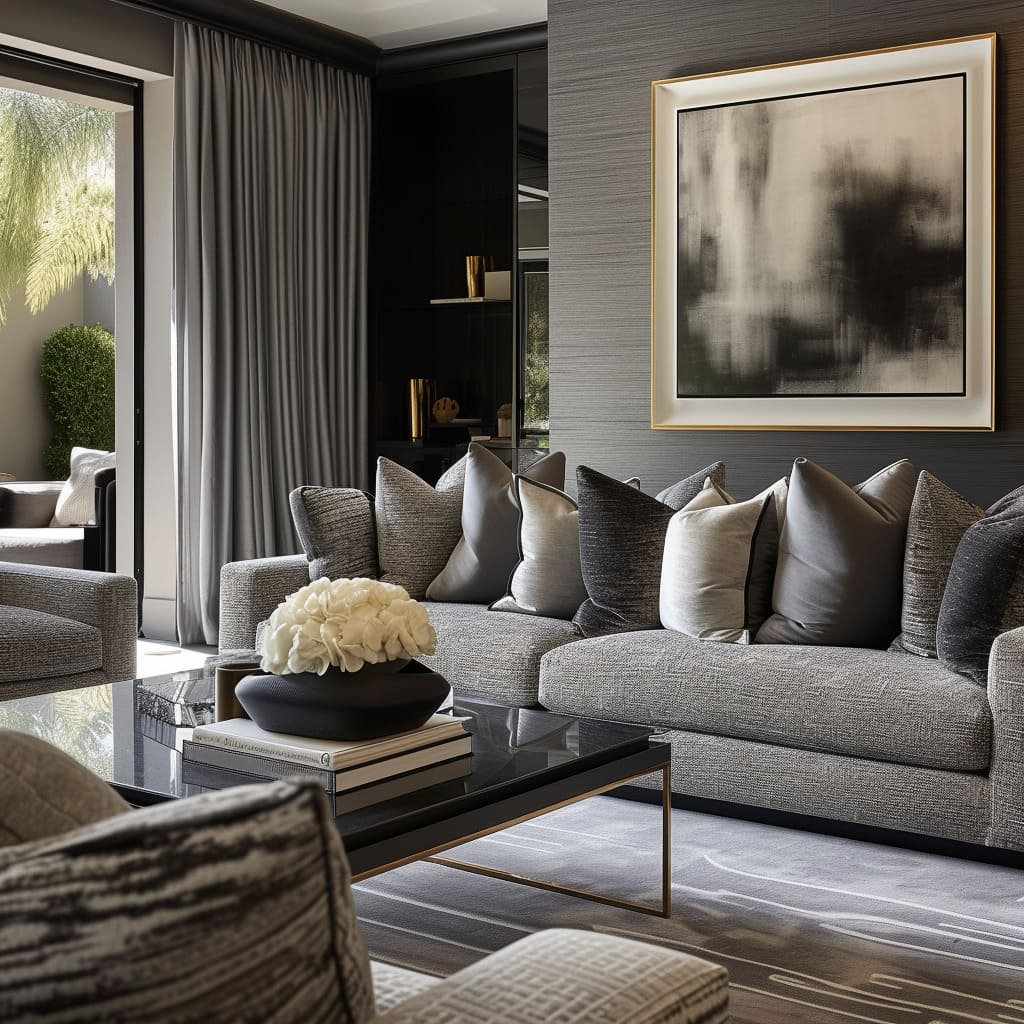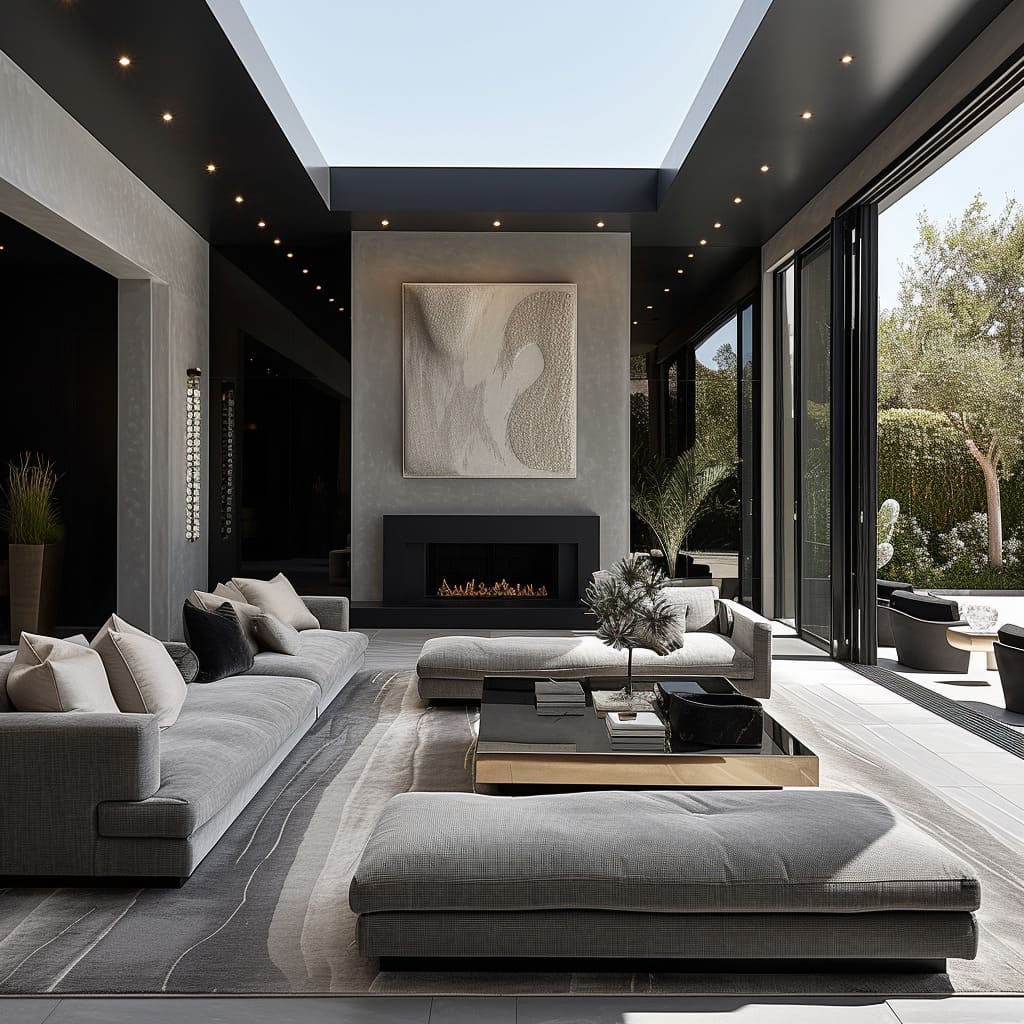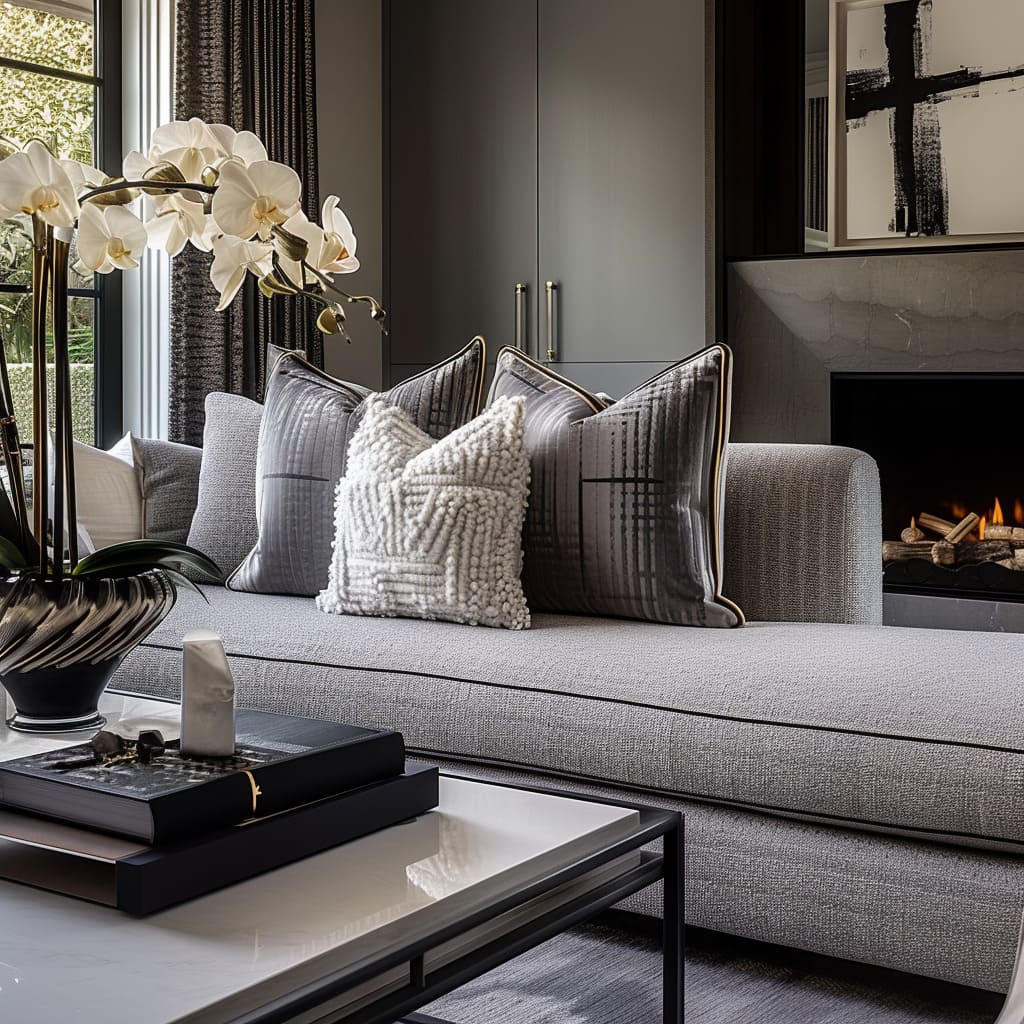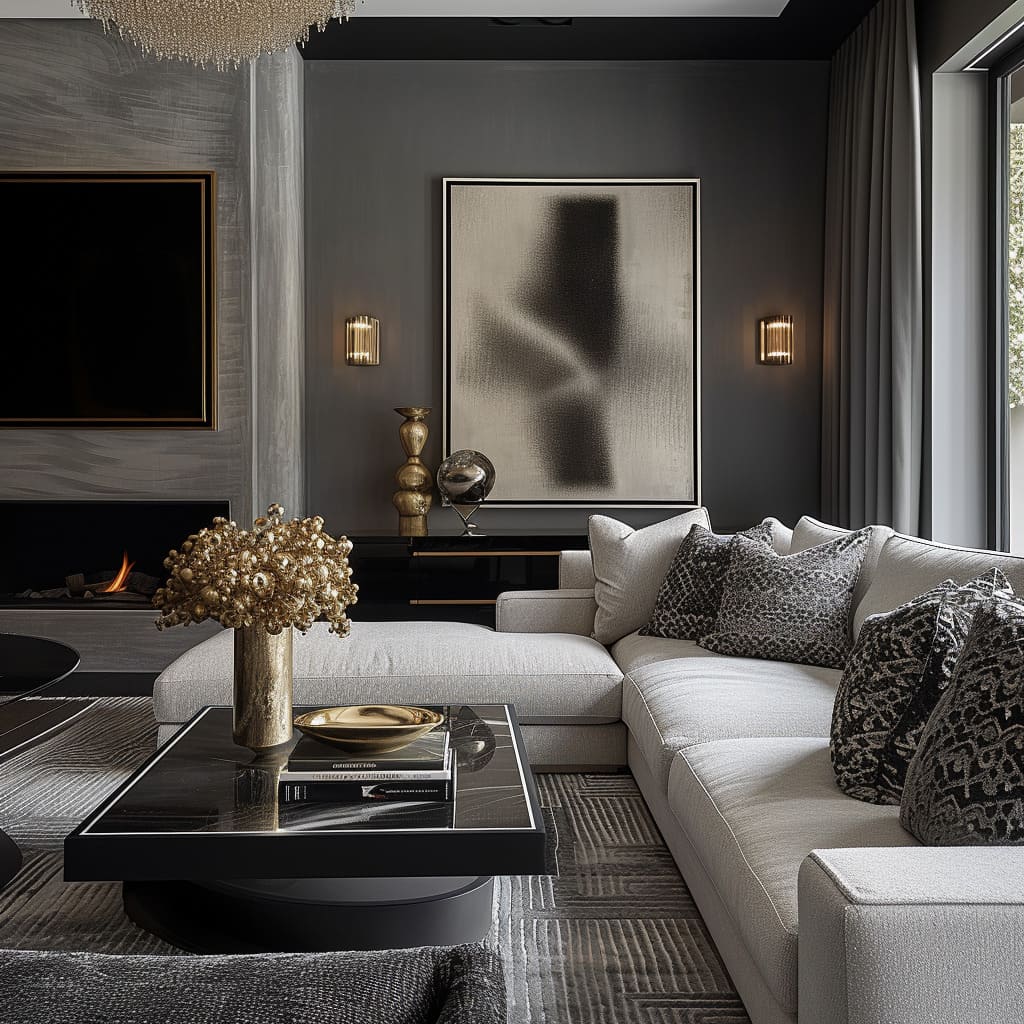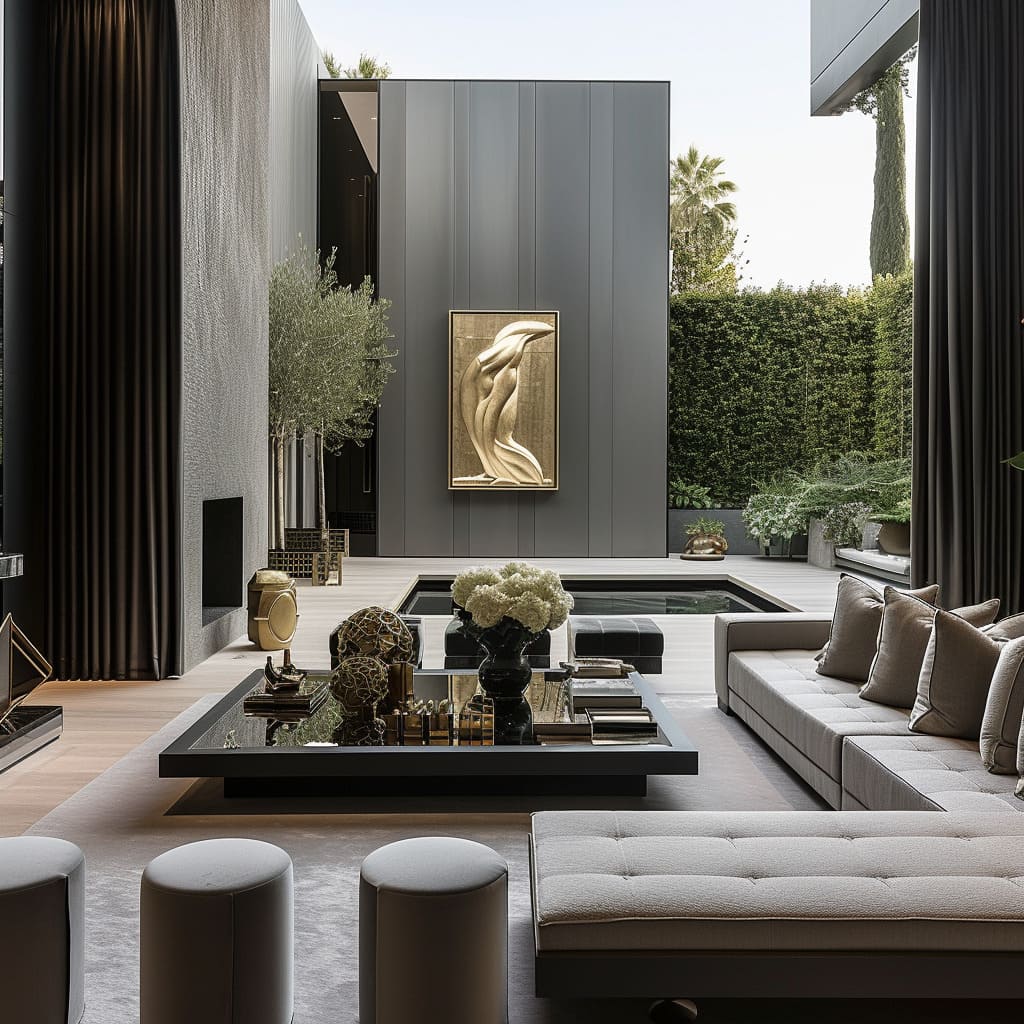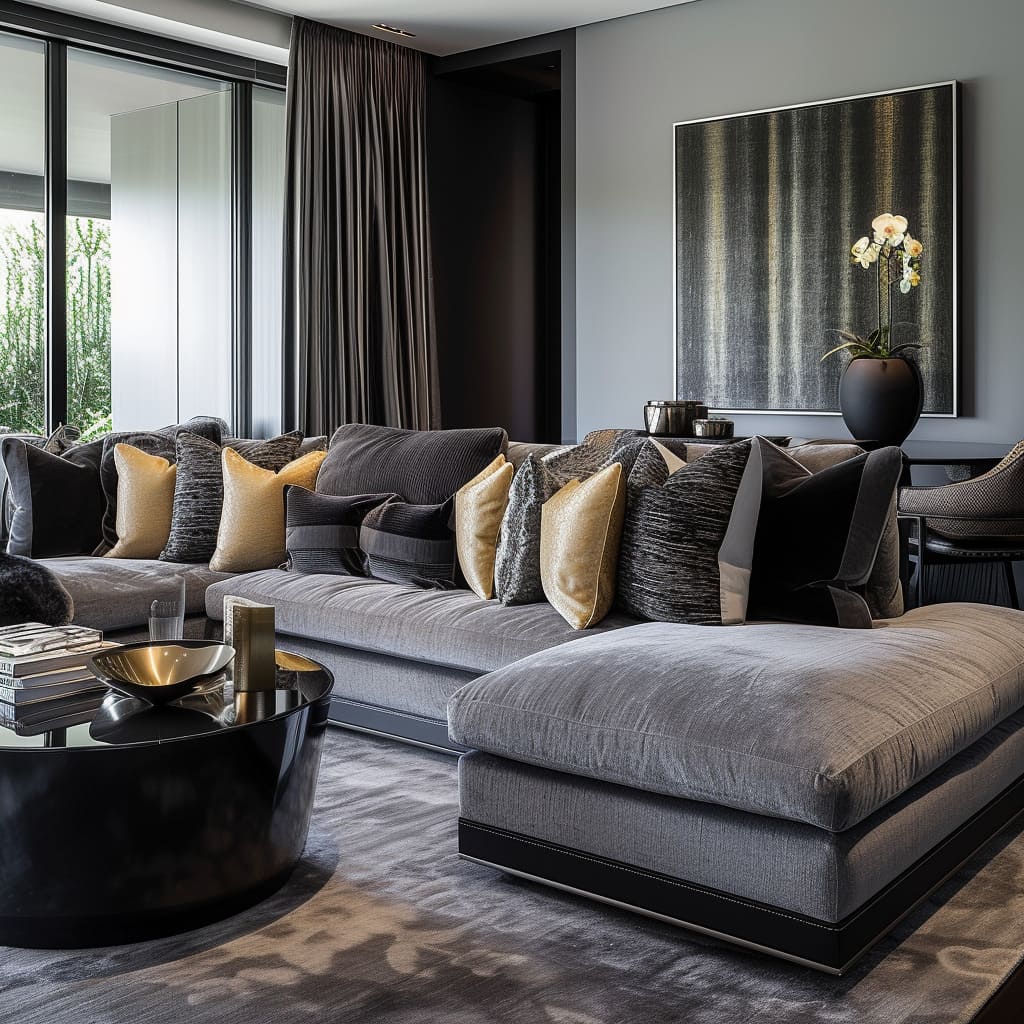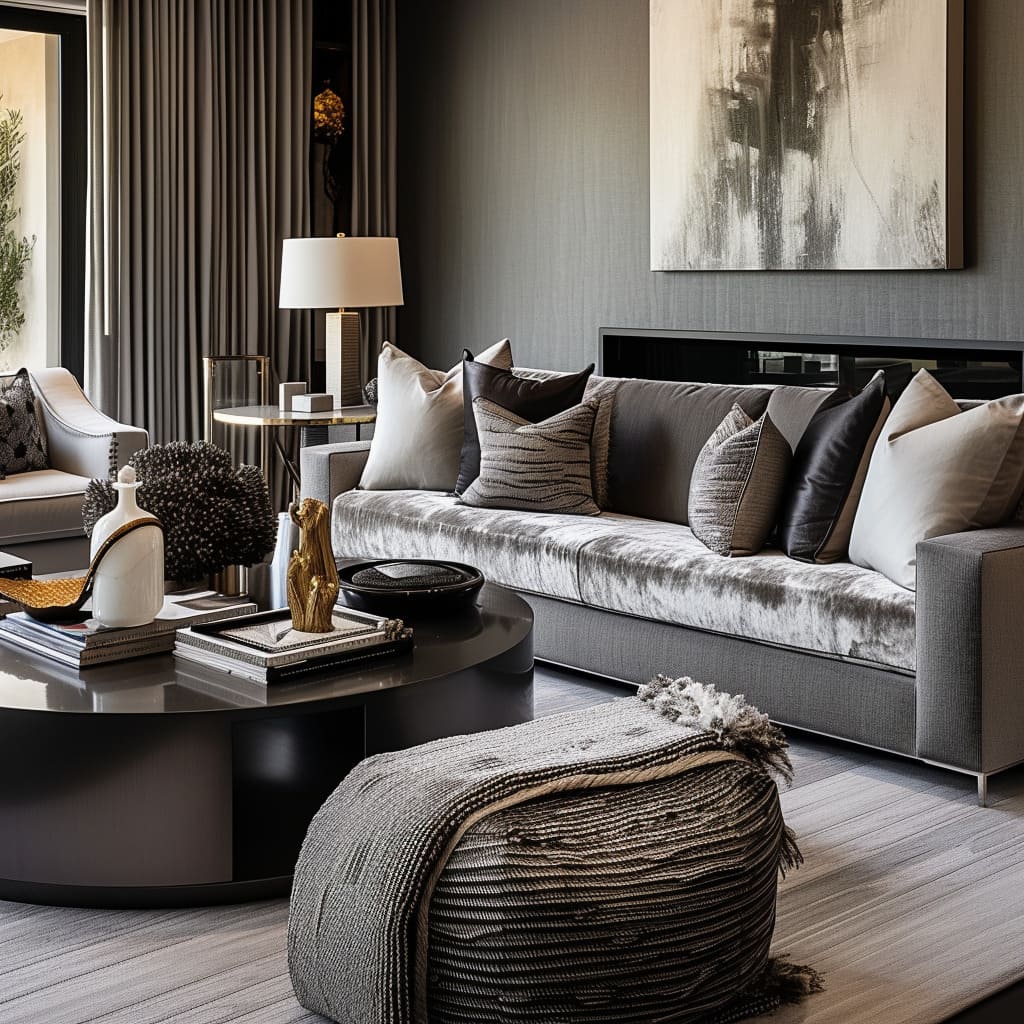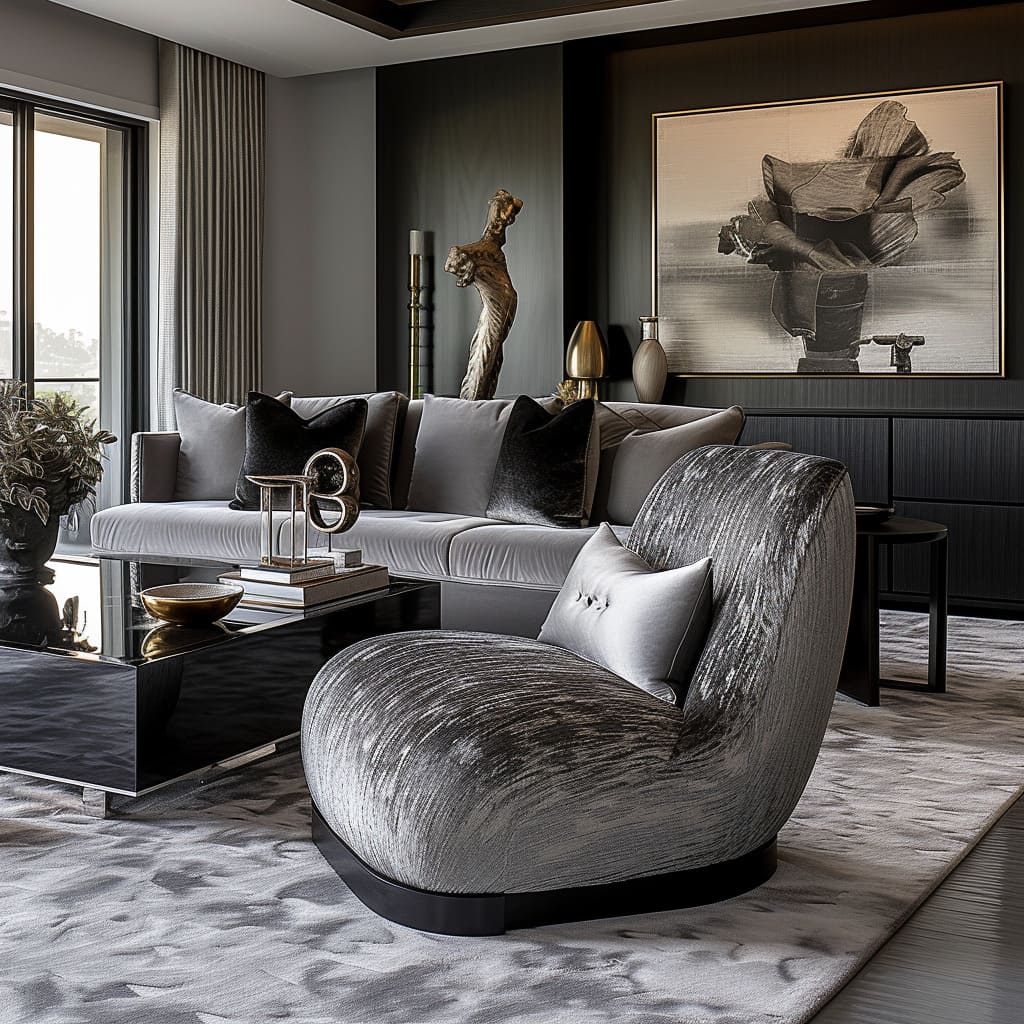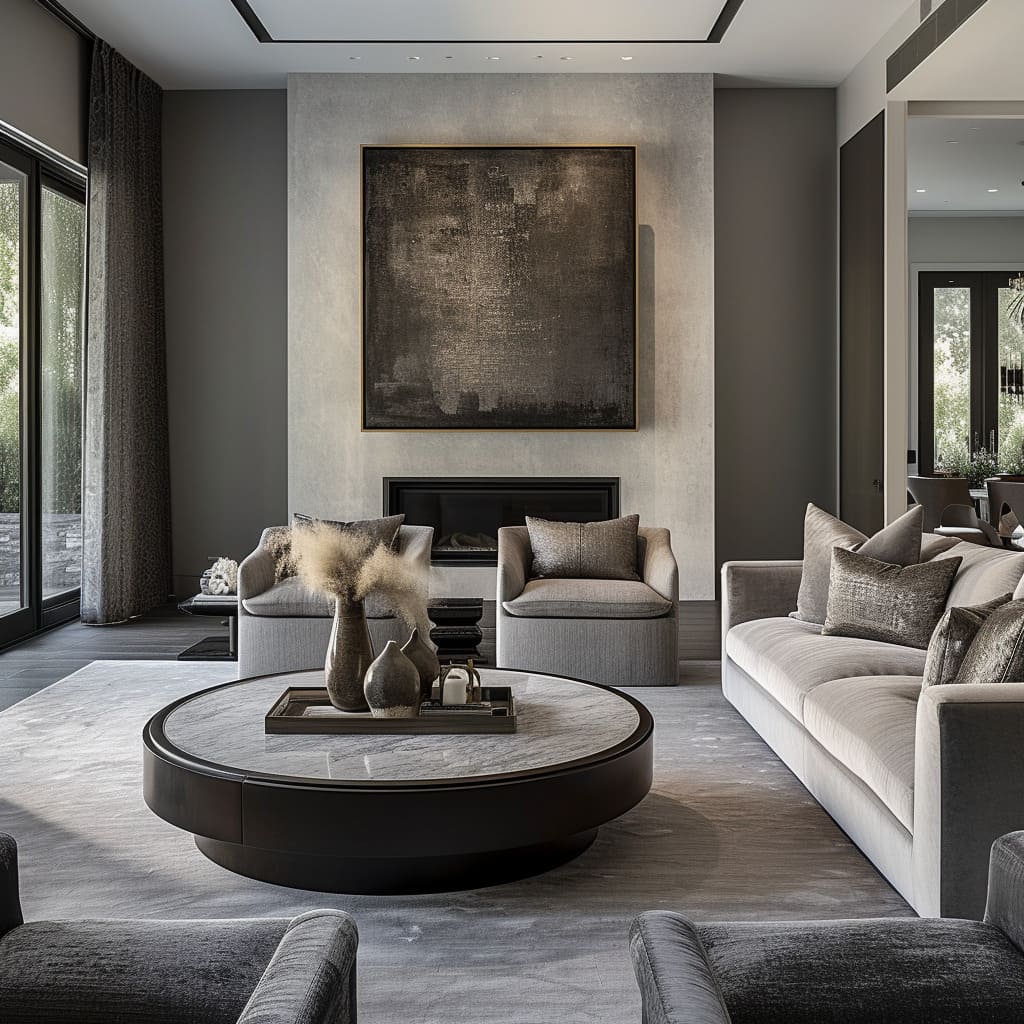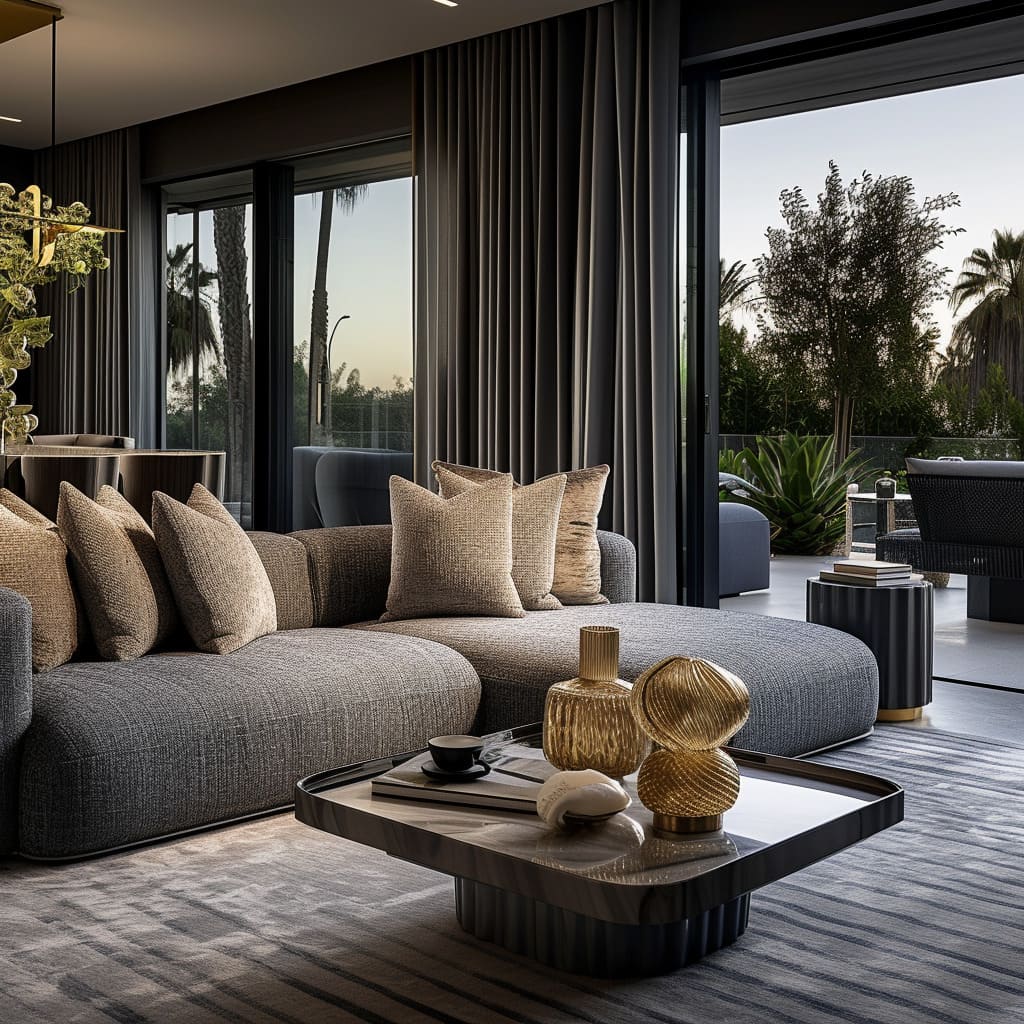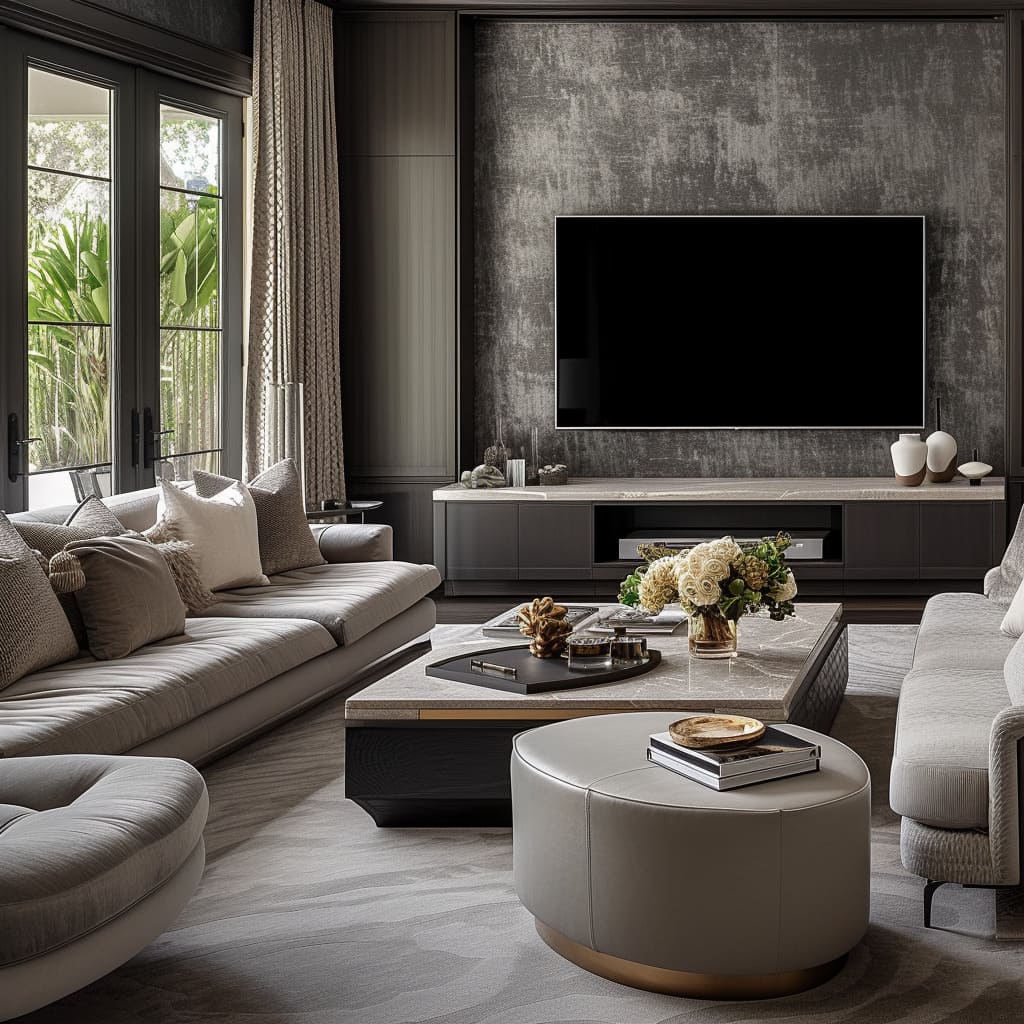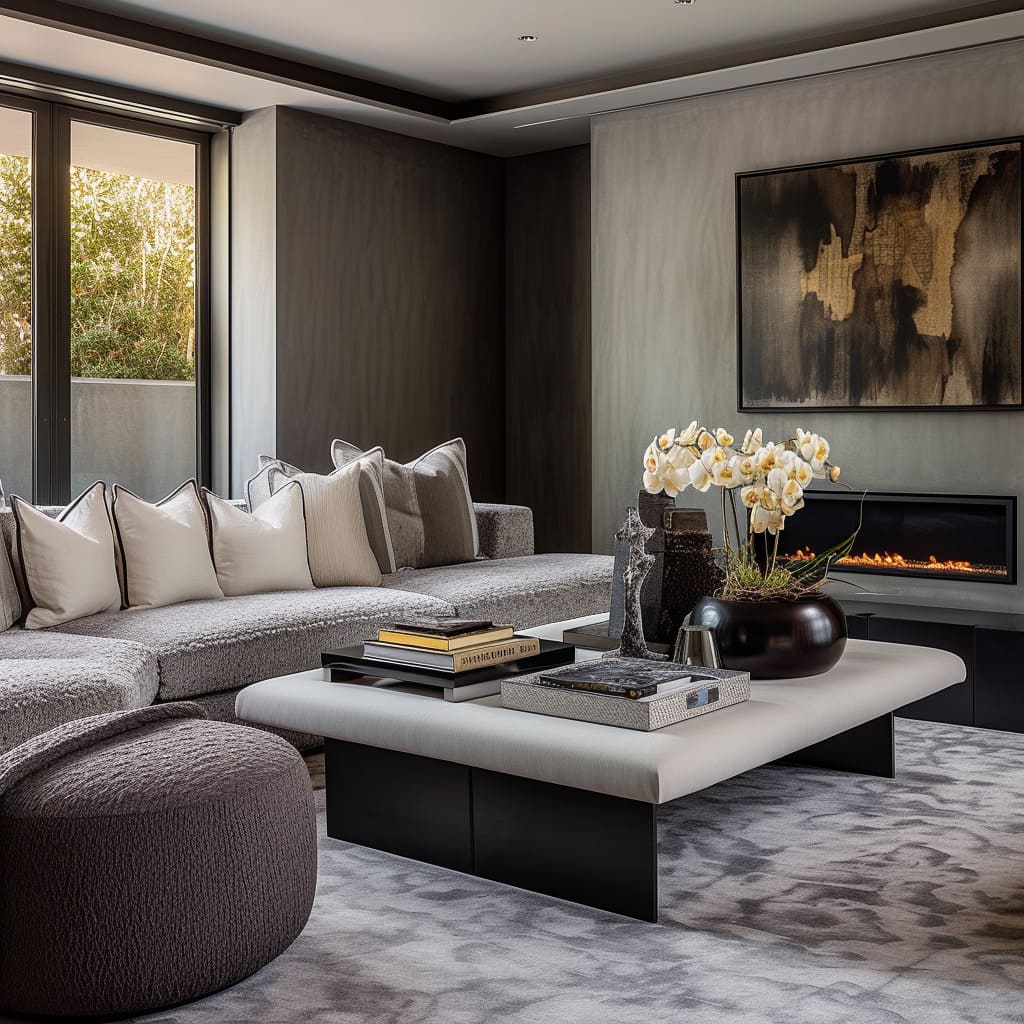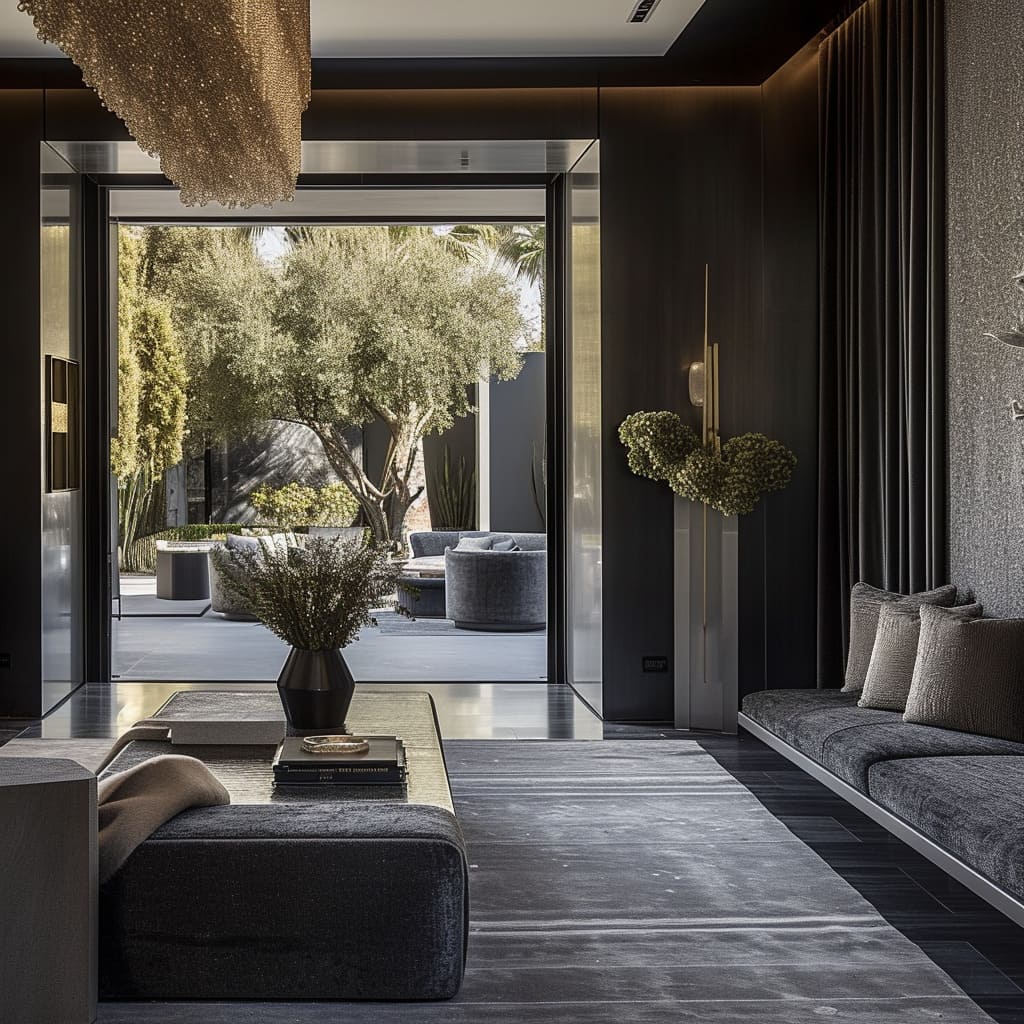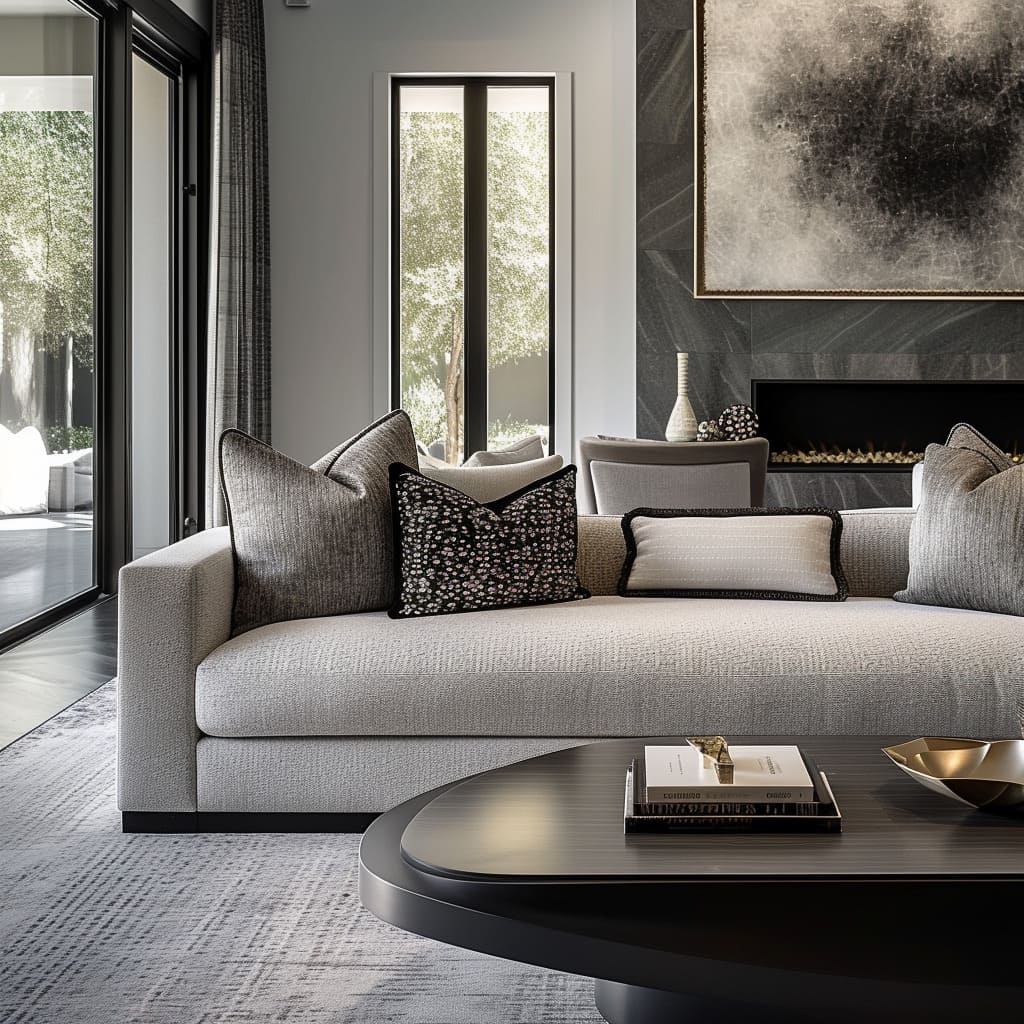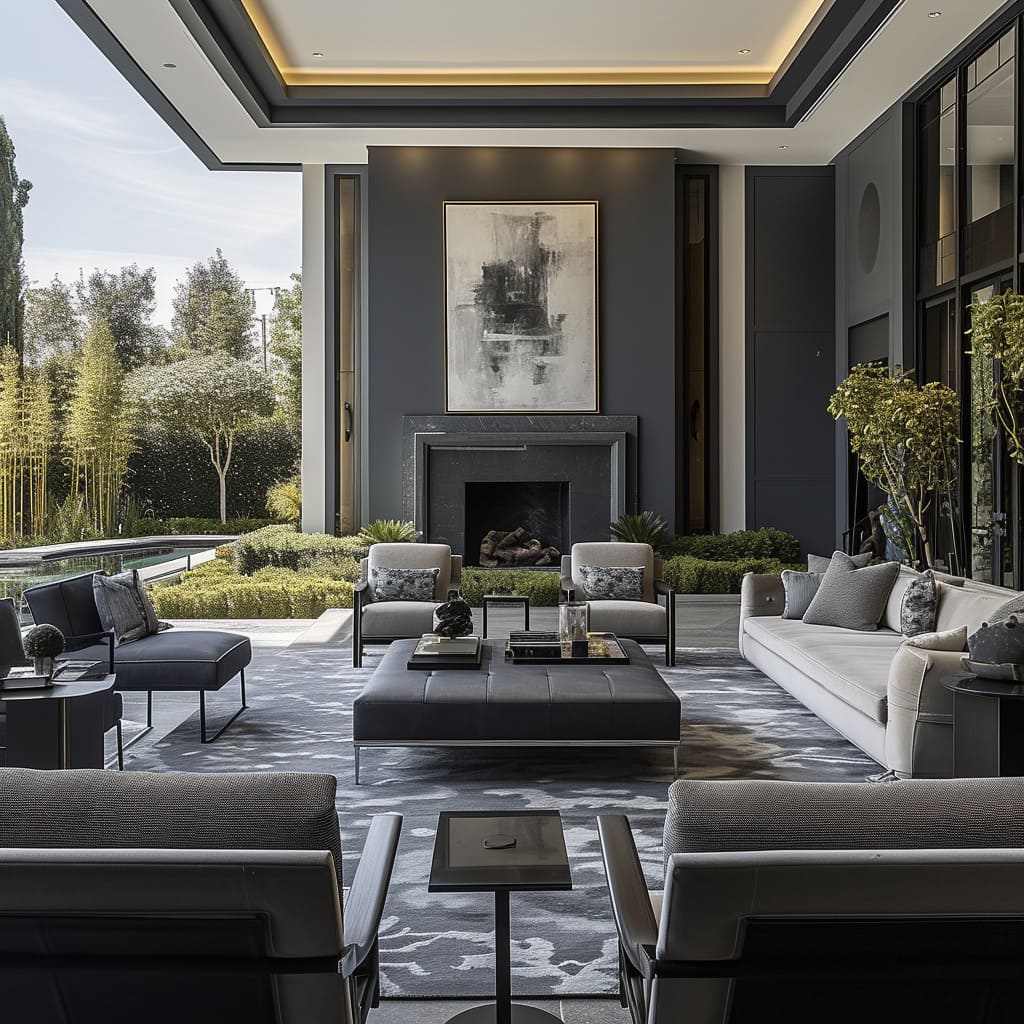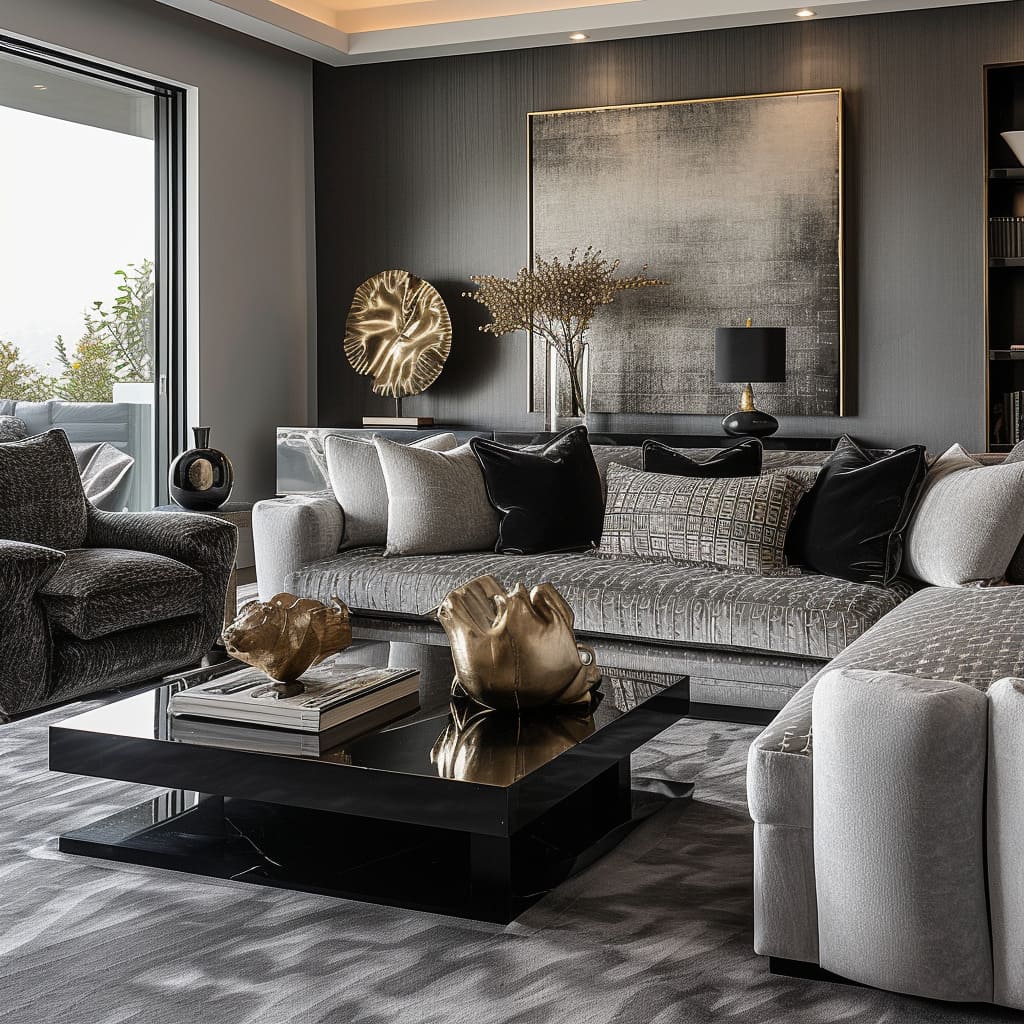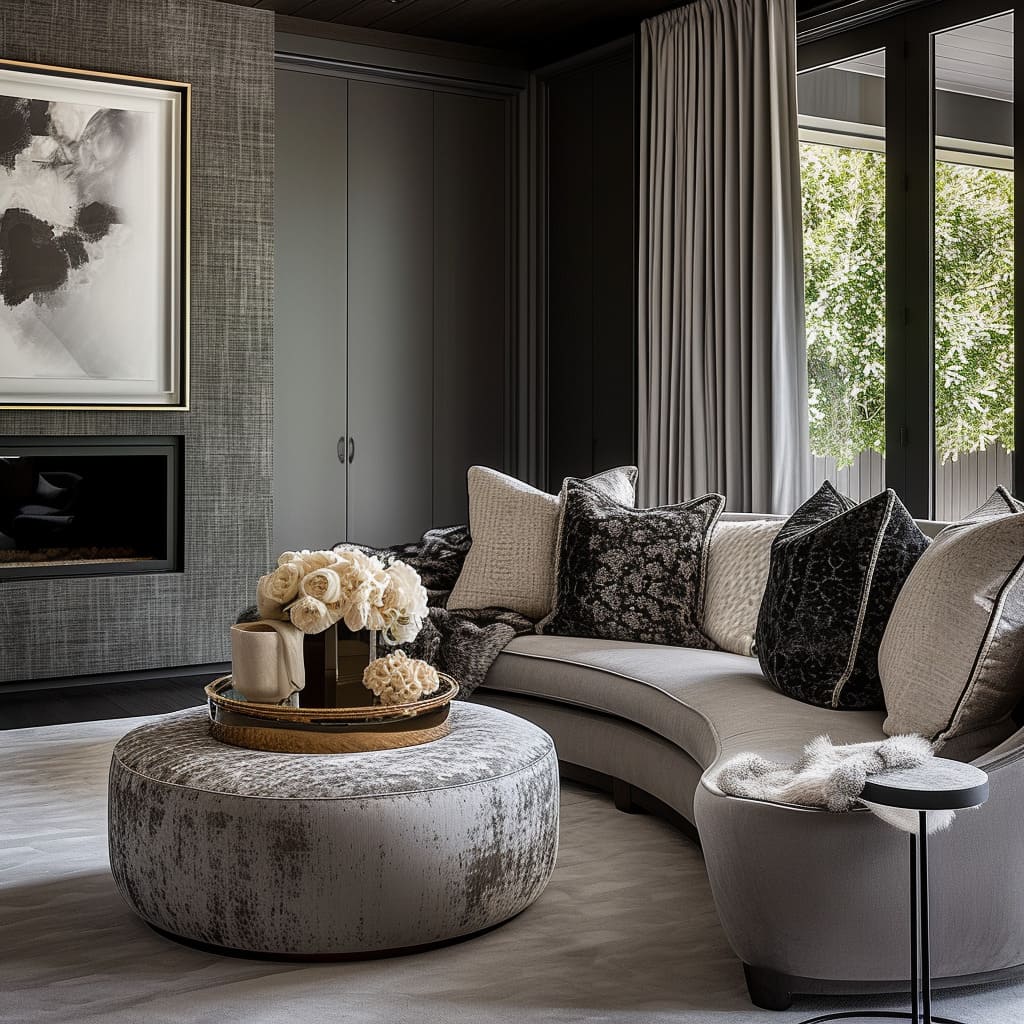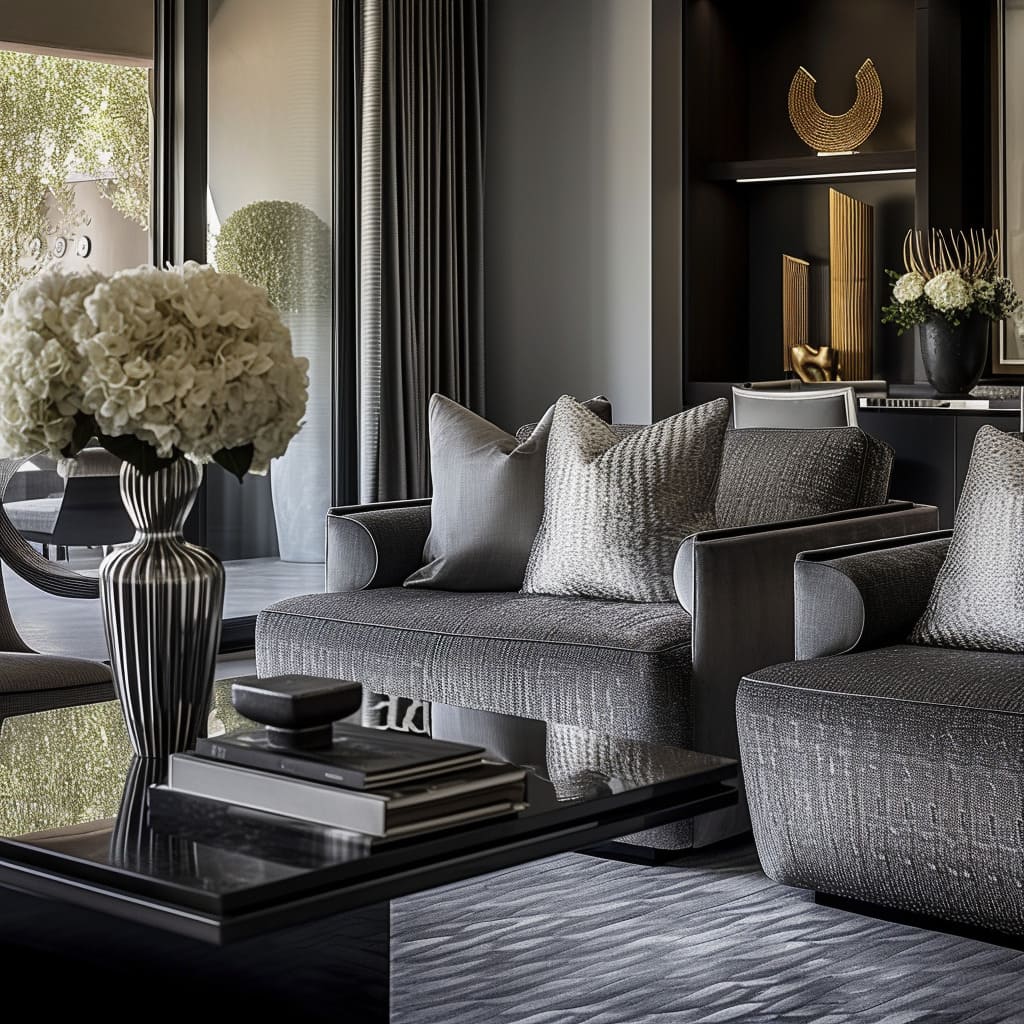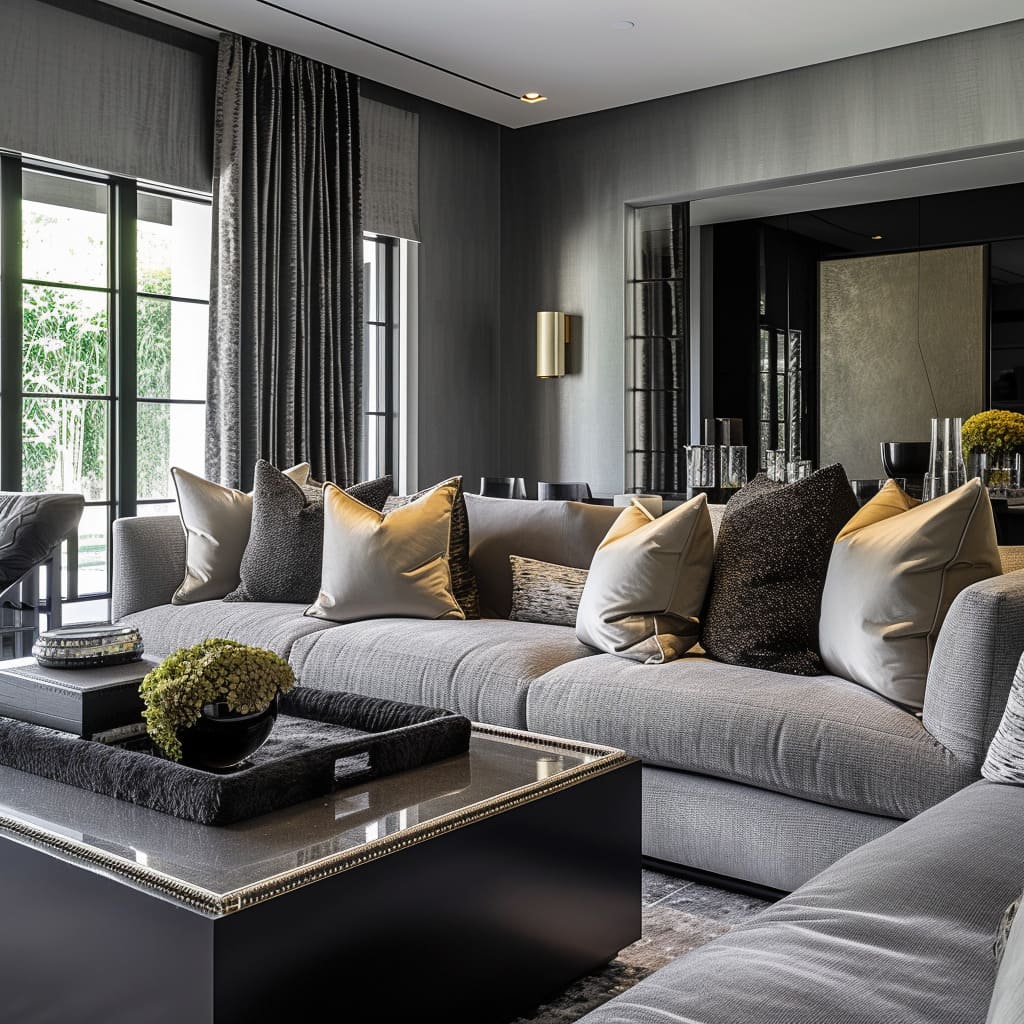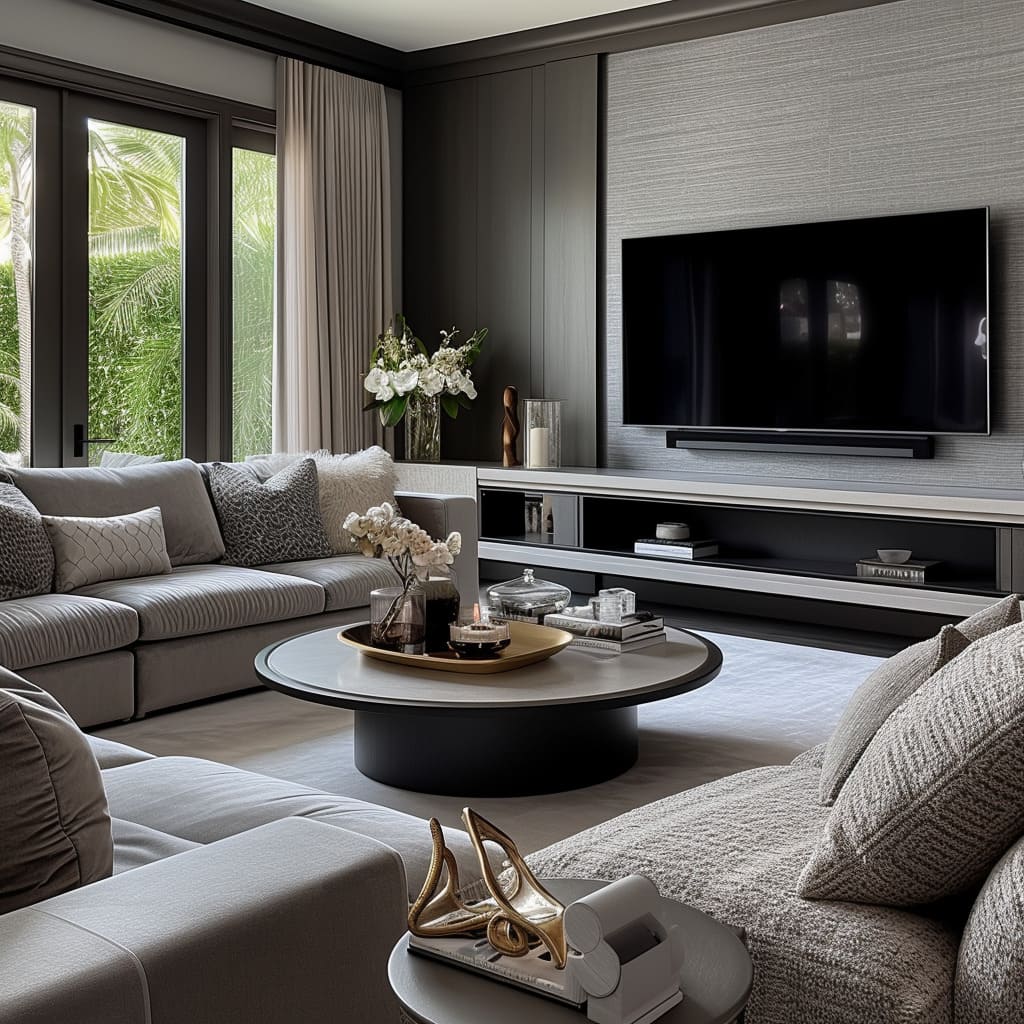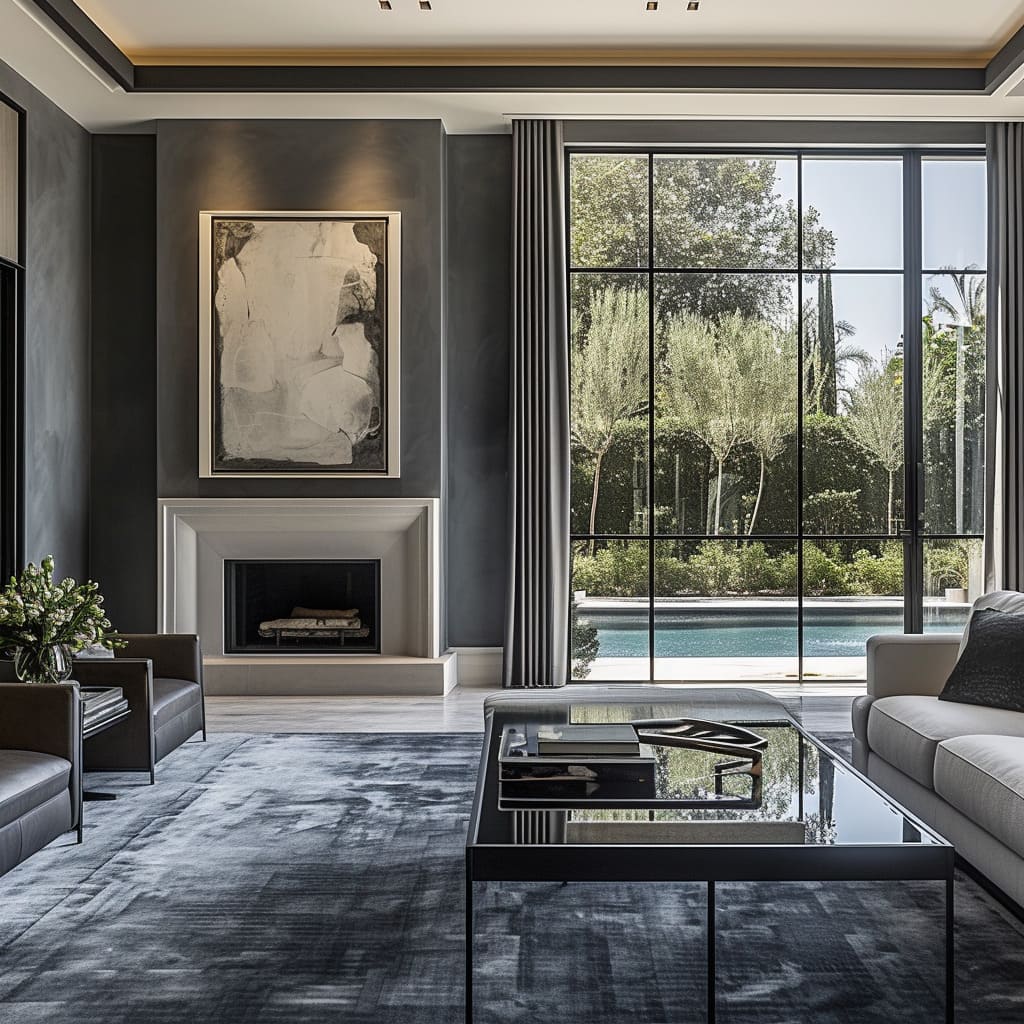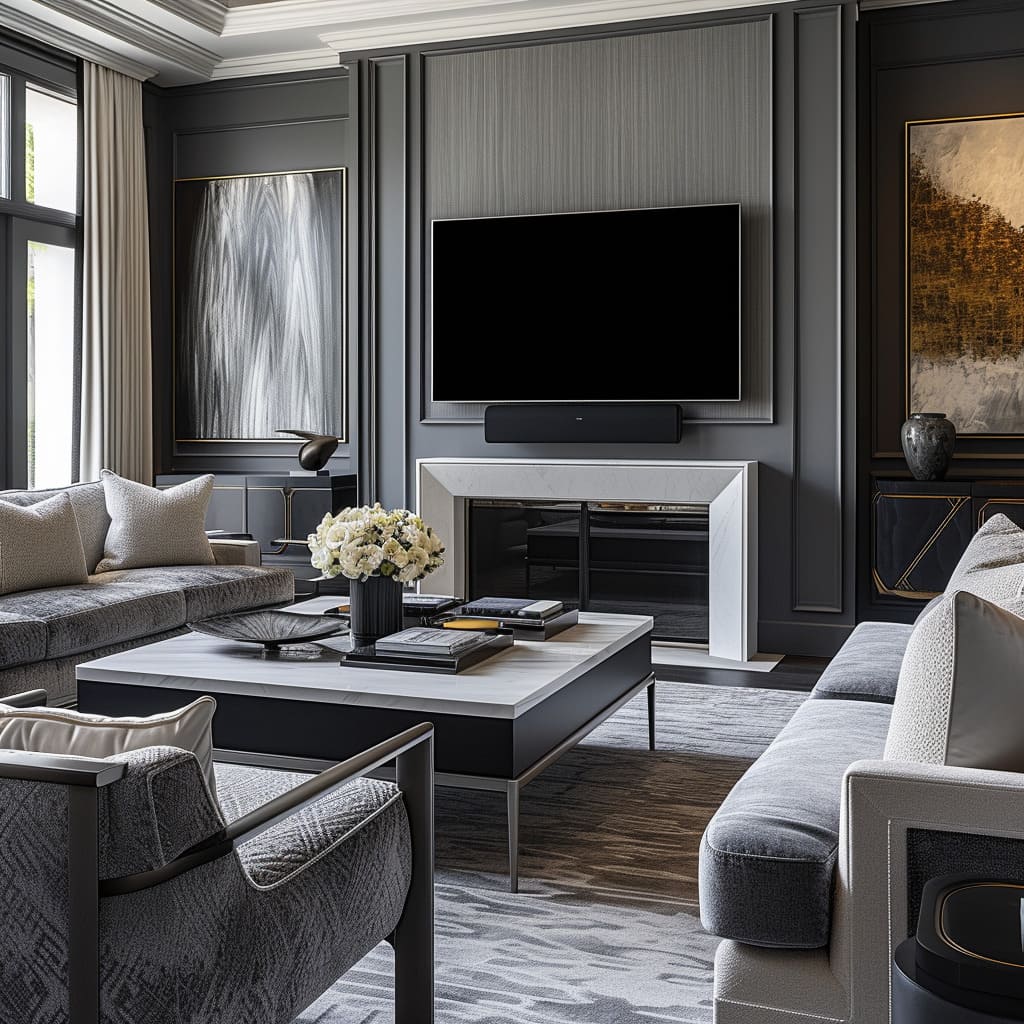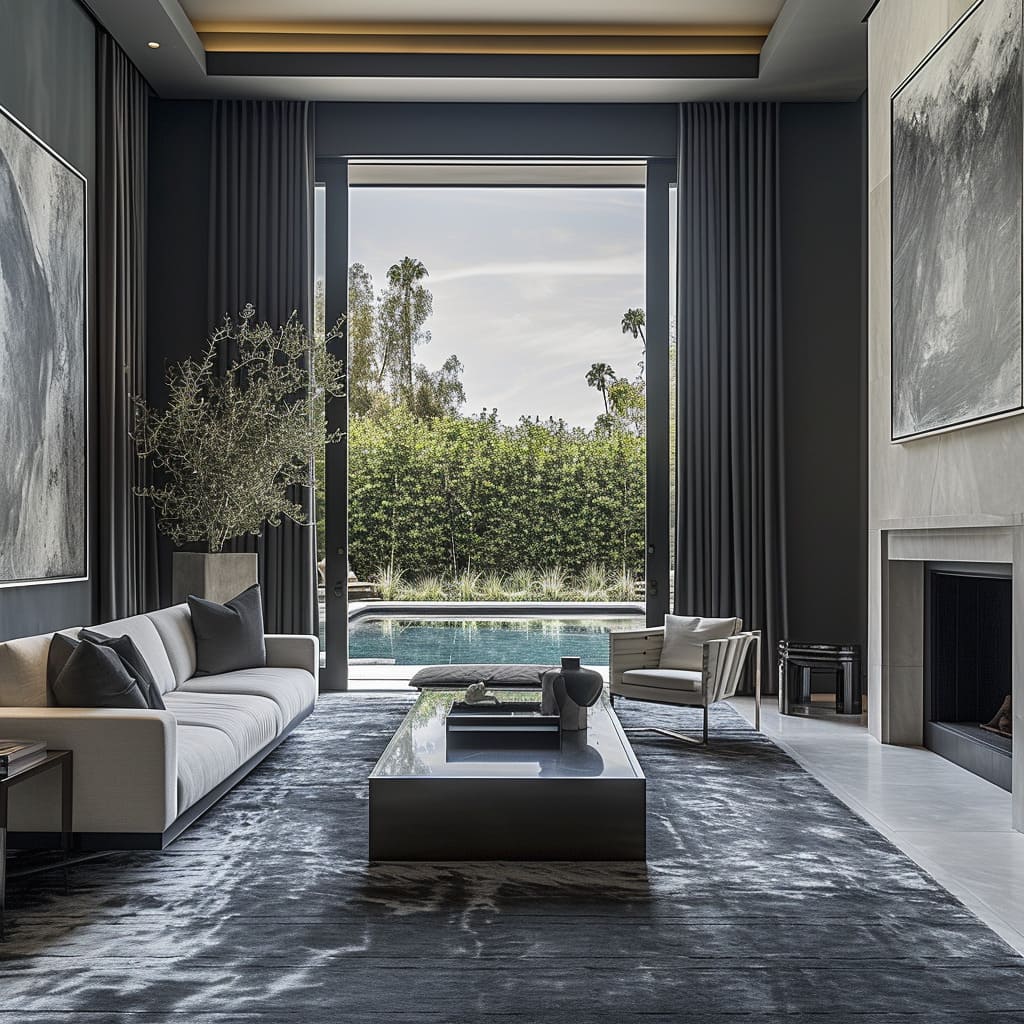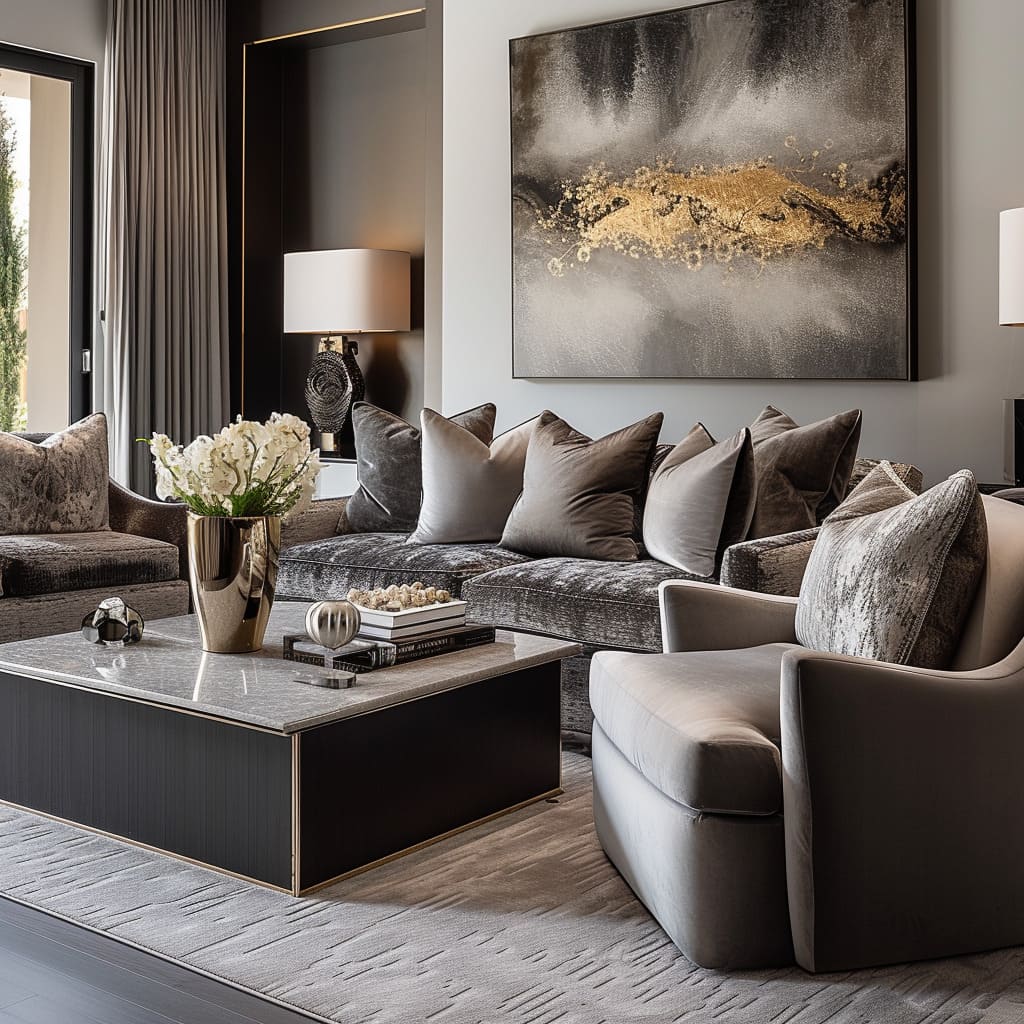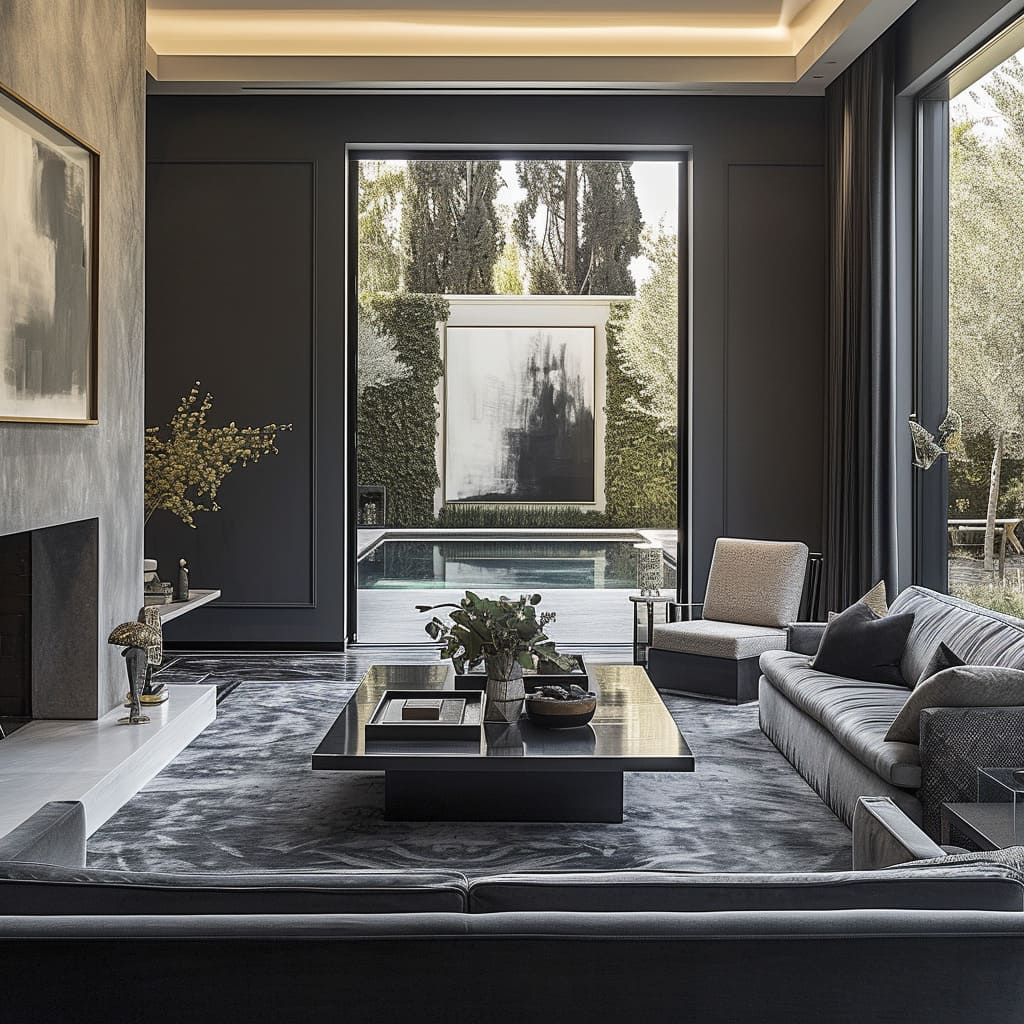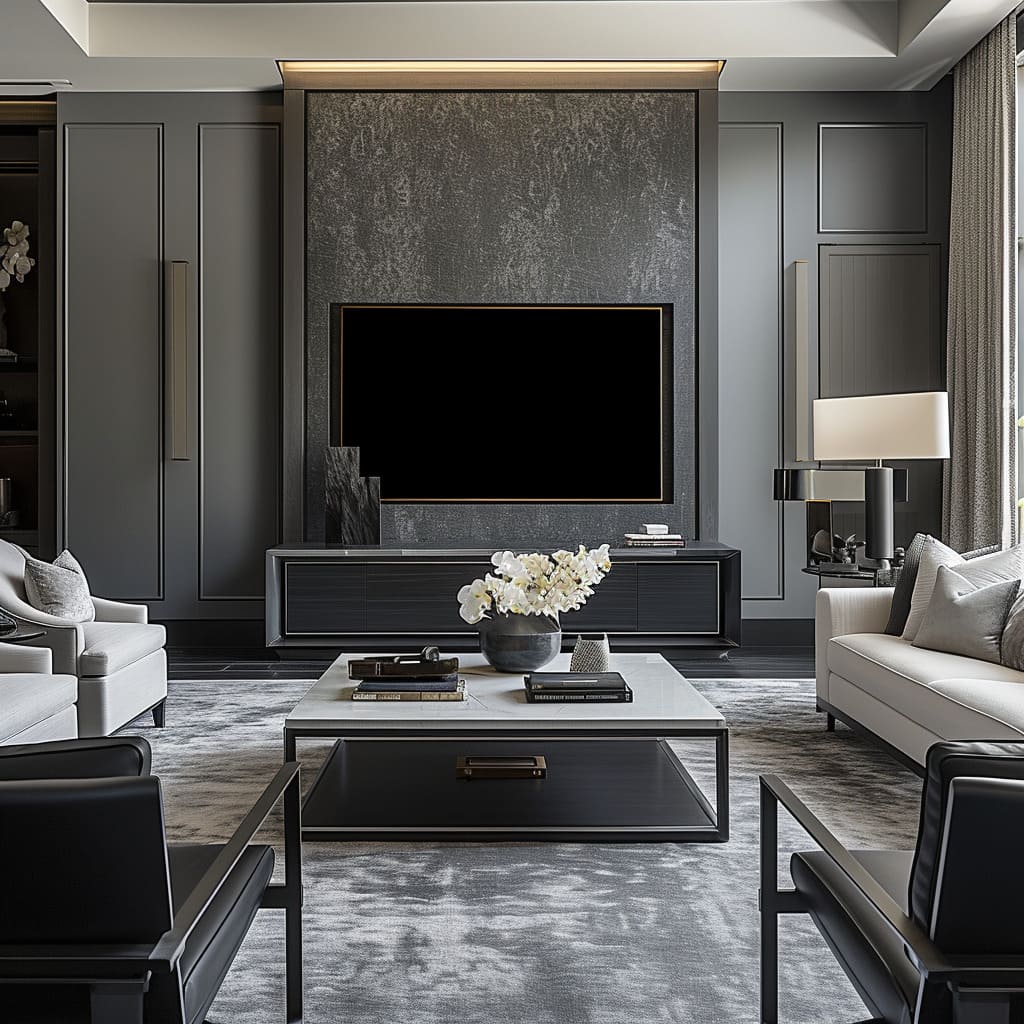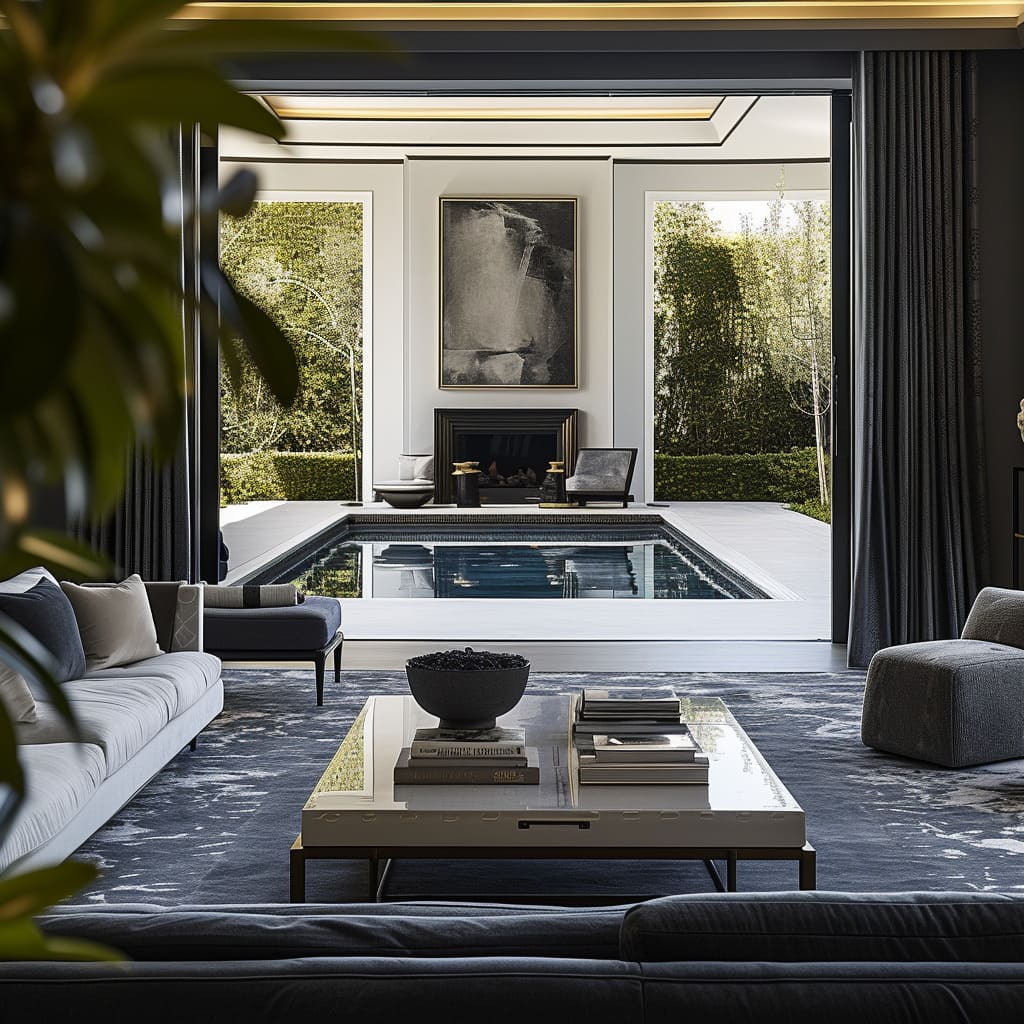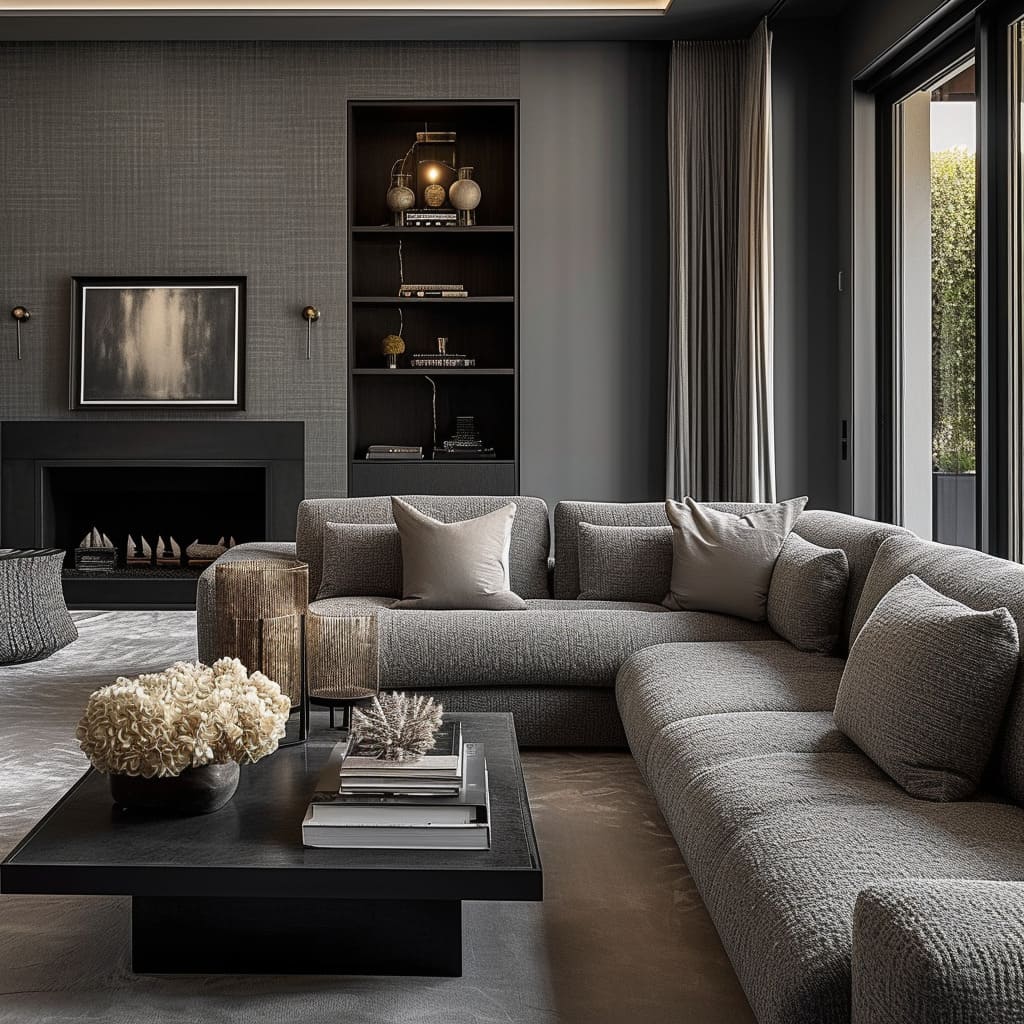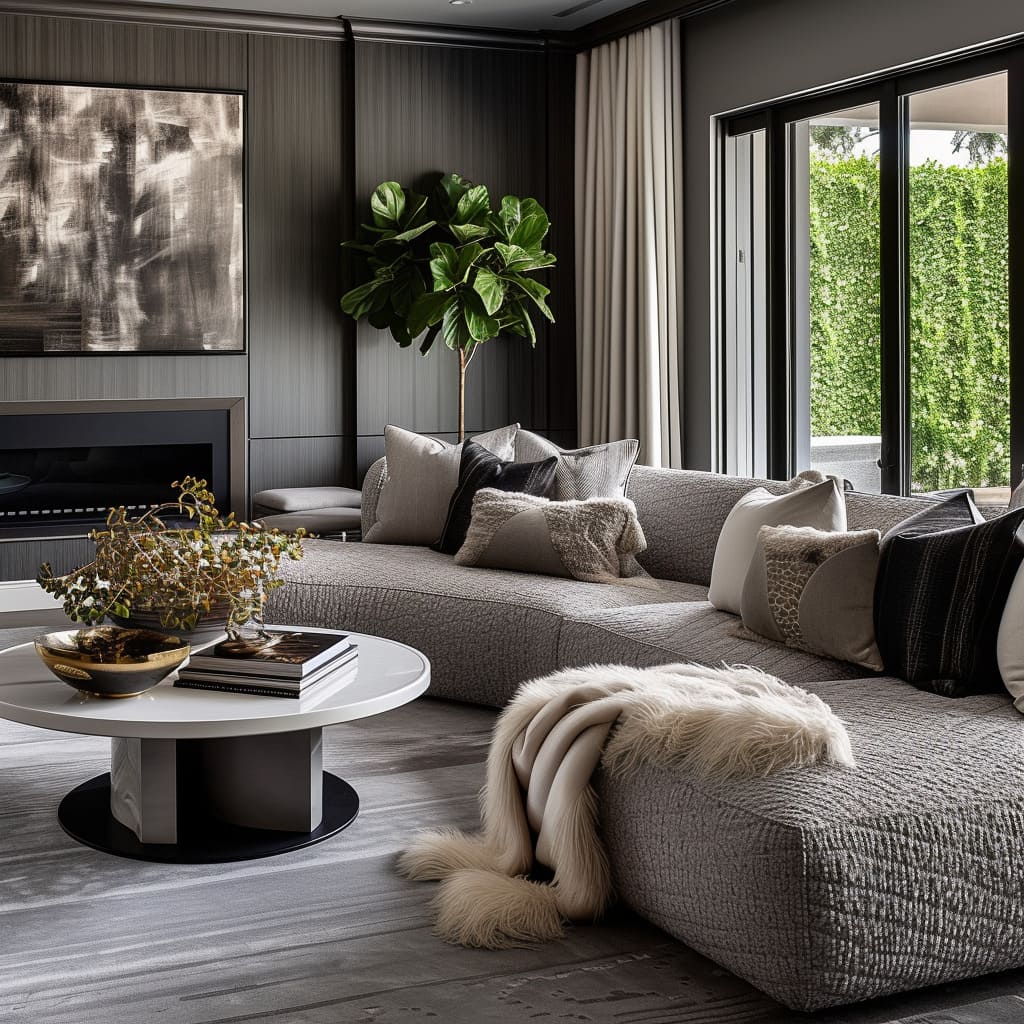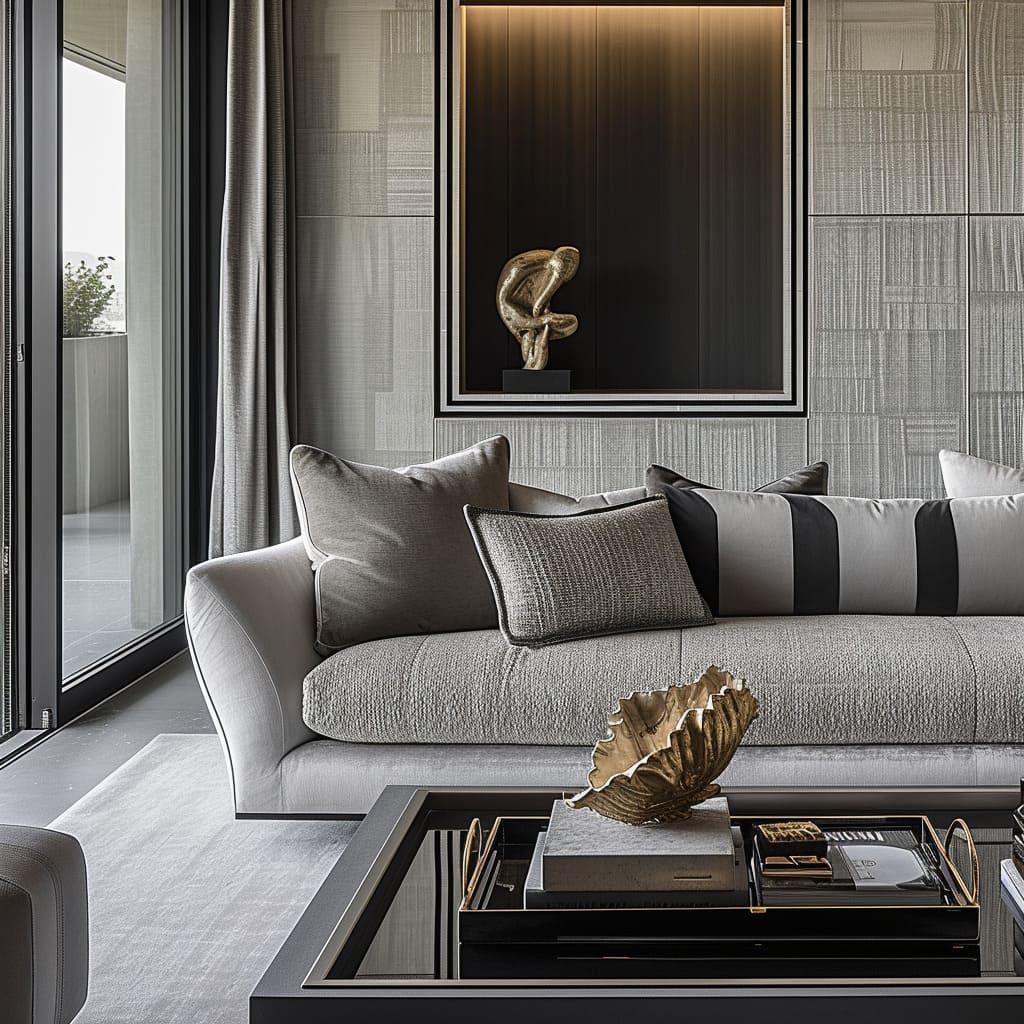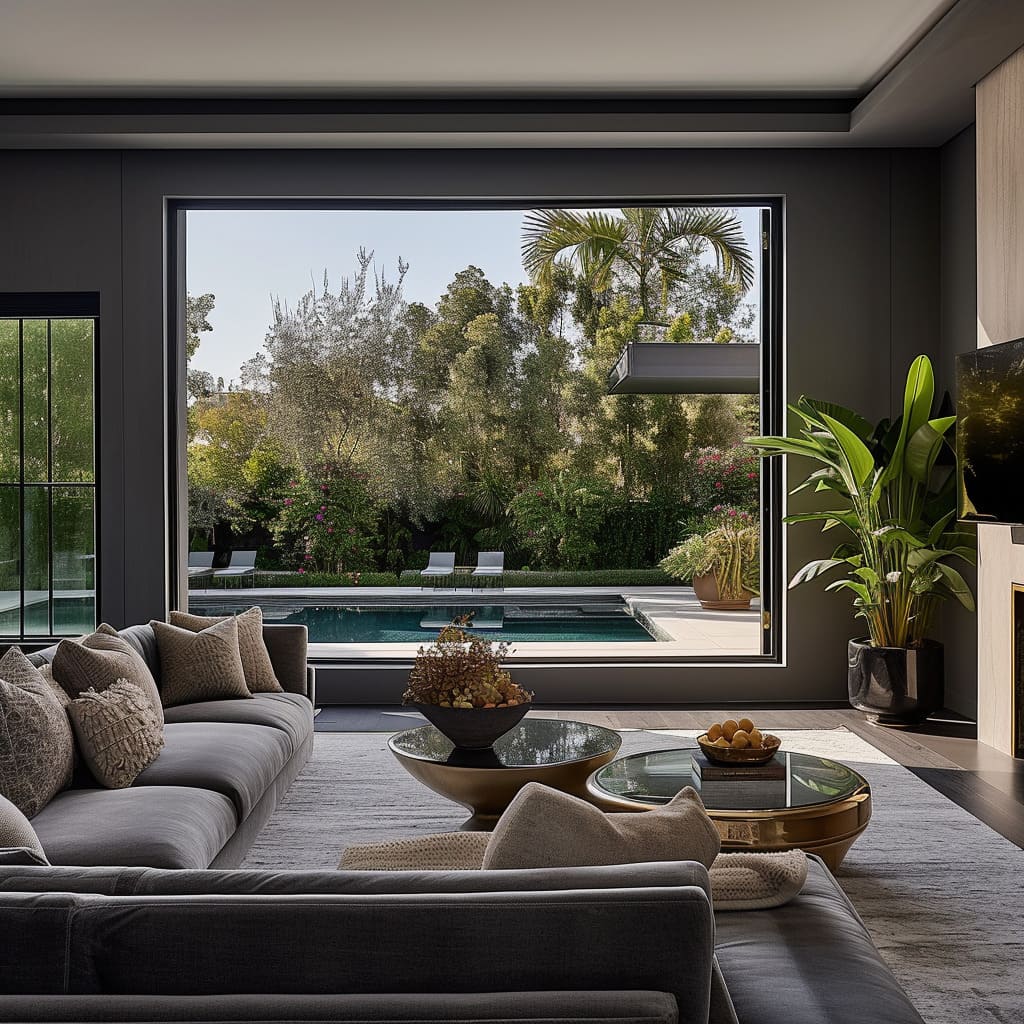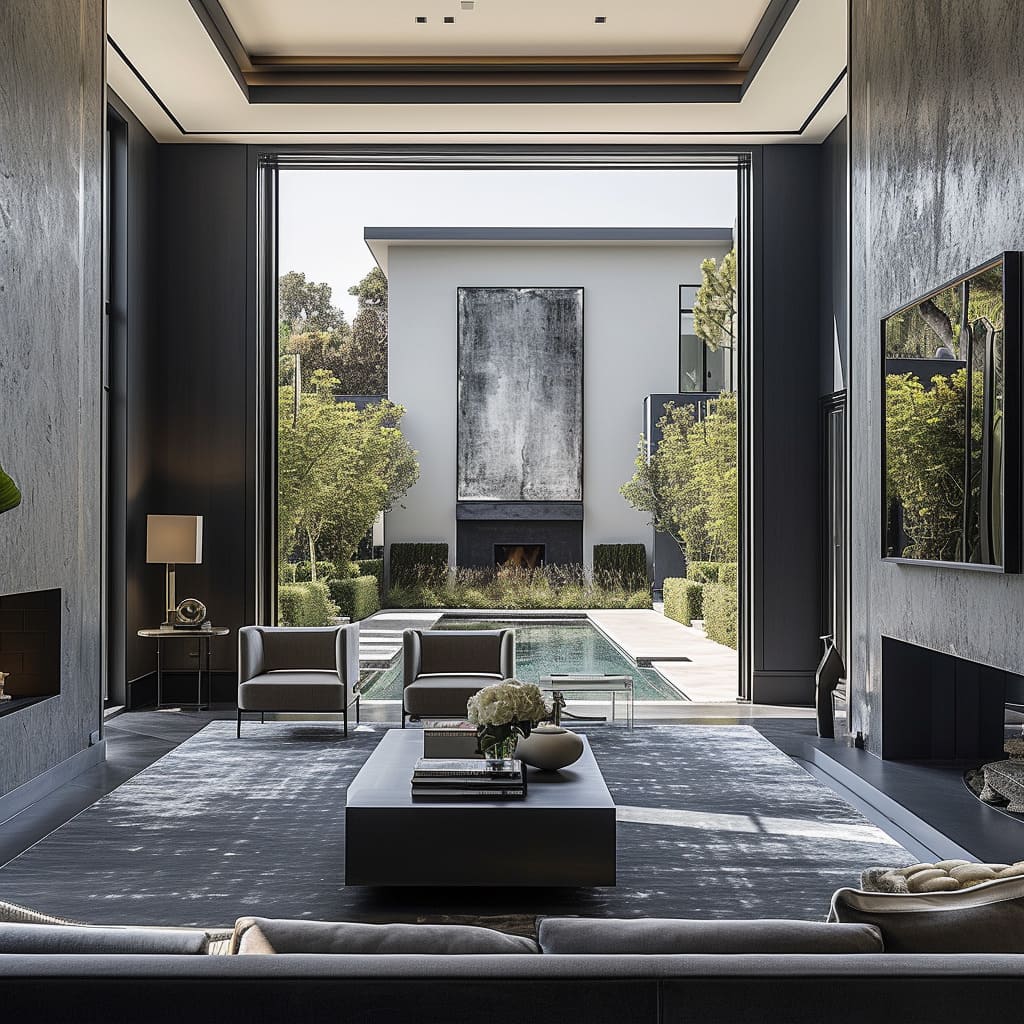In the field of interior design, the allure of gray is undeniable, providing the perfect backdrop for high-end designer furniture for rich luxury living rooms. Synonymous with sleek sophistication, it offers an impeccable canvas for a myriad of design aspirations.This comprehensive guide delves into the art of crafting luxurious living spaces adorned with rich gray hues. We explore the nuanced interplay of a monochromatic color palette, the strategic layering of diverse textures, and the integration of lustrous metallic accents atop premium Italian marble flooring in luxurious living rooms.
We illuminate the importance of opulent lighting fixtures for billionaire modern living rooms in accentuating architectural features and the pivotal role of curated artwork and accessories in infusing personality into each space. With an emphasis on high-quality materials and furniture that embodies clean, elegant lines, we demonstrate how these elements coalesce to establish an ambiance of refined luxury. Furthermore, we highlight the balancing act of incorporating natural elements according to high-end living room design trends for wealthy homeowners, which inject warmth and vivacity into the cool, composed gray backdrop. We unveil the eight cornerstone features that, when harmoniously blended, forge a living space that is not only a bastion of modern luxury but also a testament to timeless elegance.
Monochromatic Color Palette
Gray is a versatile color that can create a monochromatic look without feeling monotonous. Different shades of gray can provide depth and sophistication, allowing for a seamless integration of elements in the room.It’s an elegant backdrop that allows for a variety of textures and shapes to come to the forefront. By utilizing a range of gray shades, from the lightest silvers to deep charcoals, the interiors achieve a layered effect that is both visually coherent and intriguing.
This approach is evident in the way wall finishes in lighter grays complement darker furniture pieces, creating a balanced contrast. To successfully implement a monochromatic gray palette in your own space, consider starting with a base shade for the walls and gradually adding layers through larger furniture pieces in slightly varying tones.Accessories and smaller items can then be used to introduce the darkest or lightest shades, providing accents that tie the room together.
The key is to maintain a consistent undertone across all grays, whether it’s a cool blue-gray or a warmer taupe-gray, to ensure harmony within the space. Textured wallpapers, plush rugs, and rich fabrics in complementary gray tones can add visual interest and prevent the space from appearing flat.When dealing with a monochromatic scheme, it’s the subtle differences in texture and tone that will bring the design to life, highlighting the luxuriousness of the materials and the craftsmanship of the furniture.
Texture Variety
In rooms where color variation is limited, texture plays a key role. In a gray color scheme, textiles may include plush rugs, soft throws, and textured cushions.Surfaces like matte walls, polished marble, and brushed metal contribute to a tactile experience that adds richness and complexity to the space. The interplay of textures can be observed in the living areas where a mix of soft fabrics on upholstery contrasts with the sleekness of metal accents and the organic roughness of stone finishes.
This variety ensures that each element stands out, making the monochromatic colors feel dynamic and engaging. The layering of different textures is especially prominent in the choice of fabrics, from the woven feel of the upholstery to the smoother, almost silken touch of the cushions.
To incorporate such a variety of textures into your interior, focus on complementing the primary material of your furniture with contrasting accessories. For instance, a smooth, gray leather sofa can be enhanced with chunky knit throws and nubby woolen pillows.A room with matte-finished walls would benefit from glossy, lacquered furniture or shiny metal frames to introduce visual breaks that catch the light and create movement. Don’t shy away from incorporating unexpected materials like reflective glass or even embossed wallpapers that can mimic the feel of more expensive textures.
Consider also the functional textiles like curtains and rugs; these can bring a lush feeling underfoot with thick-pile carpets or add a breezy lightness with linen draperies. The subtle variations in the weaves and fibers of these pieces can cast varying shadows and highlights throughout the day, contributing to a living and evolving ambiance.This strategy not only enriches the aesthetic of the space but also enhances the sensory experience, inviting touch and closer inspection, which is a hallmark of luxury.
Lastly, balance is key; too much of one texture can overwhelm the senses, so aim for a thoughtful mix. Introduce a variety of finishes in your accent pieces – from the rough texture of a stoneware vase to the smoothness of a polished metal lamp base.These diverse elements should work together to create a harmonious and luxurious gray-toned space that is as tactile as it is visually appealing.
Metallic Accents
Chrome, silver, and brushed nickel are metals that naturally complement a gray color scheme. They add a touch of shine and luxury without overwhelming the space.These can be incorporated through light fixtures, hardware, and decorative objects. We see that metallic accents are used sparingly but with intention, highlighting key areas and drawing the eye with their reflective surfaces.The gleam of metal on table legs, lamp bases, and frames contributes to a modern and upscale ambiance. These reflective surfaces also serve to bounce light around the room, enhancing the sense of space and openness.
To effectively integrate metallic accents in a gray-dominated interior, consider the following strategies. Start with the larger fixtures in your space, such as lighting.An elegant chrome chandelier or sleek nickel pendant lights can serve as statement pieces that illuminate and adorn the room. Then, look to the smaller details where metal can provide an unexpected glint—door handles, drawer pulls, and decorative bowls or sculptures.
In selecting metallic accents, pay attention to the finish; brushed metals tend to diffuse light softly, creating a subtle glow, while polished surfaces reflect light more directly, offering brighter highlights. This can influence the mood and feel of the room—brushed textures tend to evoke a warm, lived-in luxury, while polished metals are more contemporary and edgy.
When incorporating metallics, also consider their shapes and designs. Clean, geometric lines can enhance the modernity of a space, while more intricate or organic shapes can add a classical or eclectic touch.The key is to maintain a cohesive design language that speaks to the overall aesthetic you wish to achieve.
Remember, balance is essential in luxurious interiors. Metallics should be used judiciously to avoid a cold or industrial feel.Pairing them with warm textures, like soft fabrics or wood grains, can create a more inviting atmosphere. By following these guidelines, metallic accents can elevate a gray color scheme into a sophisticated and luxurious space that feels both cohesive and inviting.
Layered Lighting
Luxurious interiors often feature a variety of light sources, including ambient, task, and accent lighting. With a gray palette, lighting becomes even more critical to highlight the different tones and textures.Integrated ceiling lights, elegant standing lamps, and subtle under-shelf lighting can create a dynamic and inviting atmosphere. The living rooms exhibit this concept with the use of vertical floor lamps that add height and draw the eye upward, and table lamps that provide a localized glow, creating intimate pockets of warmth.Recessed ceiling lights offer a wash of ambient light, while directional spotlights accentuate artwork and architectural details, adding depth and drama to the spaces.
For those looking to incorporate layered lighting into their gray-themed interiors, start by assessing the natural light sources and planning your lighting to complement them. Ambient lighting can be achieved with ceiling fixtures that cast a diffuse light, reducing harsh shadows and creating a welcoming baseline of illumination.Task lighting should be considered next, with desk lamps or pendant lights over work areas providing focused illumination for specific activities.
Accent lighting is where you can really play with drama and atmosphere. Consider LED strip lighting along shelving to highlight decorative objects or in coves for a soft uplighting effect.Artistic sconces can serve dual purposes, acting as both light sources and sculptural elements on a wall. Even the choice of bulbs is important; warmer tones can soften a cool gray palette, whereas cooler tones can reinforce the sleek, modern vibe of the space.
Finally, don’t overlook the power of dimmers. Being able to adjust the intensity of lighting means you can alter the ambiance of the room for different occasions, from bright and energetic to soft and serene.Remember, the goal is to create layers that not only enhance visibility but also add to the overall aesthetic and mood of your luxurious gray space. With thoughtful placement and the right fixtures, lighting can become an integral design element that enlivens and enriches the entire room.
Artwork and Accessories
In a primarily gray space, artwork can serve as a focal point. Large-scale paintings with textured finishes or abstract designs in monochromatic or contrasting hues add interest and personality to the room.Accessories like vases, sculptures, and books provide an opportunity to introduce other colors or double down on the gray theme. The living room interiors provided showcase artwork that commands attention through size and design, often taking up a considerable portion of the wall space and complementing the gray tones with either stark black and white contrasts or subtle metallic sheens.The art pieces are carefully selected for their ability to blend with the room’s color palette while also providing a break from the uniformity of the gray backdrop.
To incorporate artwork and accessories effectively into a gray-dominated interior, focus on selecting pieces that resonate with the room’s overall aesthetic. For example, a minimalist space may benefit from a single large abstract painting with a burst of color to provide a stark contrast against the gray.Alternatively, a series of black and white photographs can enhance a modern industrial look without straying from the color scheme. Check out luxury black living room ideas if you’re looking for almost black design inspiration.
When choosing accessories, consider their form and texture as much as their color. A rough, stone sculpture or a smooth, ceramic vase can add depth and complexity to the space.Books with richly colored spines can act as pops of color on a coffee table or shelf, and they can also reflect your personal interests and tastes, adding an intimate touch to the decor.
Moreover, don’t be afraid to mix metallics with matte or glossy finishes to diversify the visual experience. A shiny metal bowl on a matte gray table, or a cluster of matte ceramic vessels on a polished shelf, can create an engaging play of textures and finishes.Remember to curate these pieces thoughtfully to maintain a sense of harmony and intention within the space.
Lastly, consider the scale and placement of these decorative elements. Large pieces can be grounding, while smaller items should be grouped for impact rather than scattered randomly.Accessories and artwork can be used to draw the eye and guide the movement through the room, creating a narrative that complements the luxurious and thoughtful design of a gray-toned space.
High-Quality Materials
Luxurious interiors are characterized by the use of high-quality materials that are both beautiful and durable. With a gray theme, materials like suede, velvet, silk, and high-thread-count linens add a sense of indulgence, while stone, glass, and polished wood provide longevity and timelessness.The gray color palette is enriched with the use of varied materials; for instance, the suede and velvet offer a visual softness and an inviting texture that tempts the touch, while silk cushions give a subtle sheen that contrasts with the matte surfaces surrounding them. Stone tabletops and accents suggest sturdiness and organic beauty, and glass elements contribute to a modern, clean aesthetic that captures and refracts the light.
To integrate high-quality materials into your own gray-themed interior, prioritize textiles that provide both comfort and aesthetic appeal. For seating, select high-density foam cushions covered in durable suede or velvet to provide long-lasting comfort and a luxurious look.Silk throw pillows can be used for a splash of elegance and can be easily interchanged to update the room’s style.
In choosing harder materials, opt for natural stone like granite or marble for countertops and accent tables, ensuring longevity and a unique pattern in each piece. Consider incorporating glass in the form of tabletops or decorative pieces to add a contemporary edge and open up the space.Polished wood, whether it’s in flooring, furniture, or decorative accents, adds warmth and a natural element that can balance the cooler gray tones.
The key to successfully incorporating these materials is in the balance; too much of one can overwhelm the space. A plush velvet sofa might be offset by a sleek glass coffee table, while silk curtains can complement a rugged stone fireplace.Choose each piece for its ability to stand the test of time both in terms of style and durability.
When selecting these materials, consider not only their quality but also their source. Sustainable and ethically sourced materials are increasingly important in luxury design, adding an additional layer of value and storytelling to the space.High-quality materials are an investment, and when chosen wisely, they can transform a simple gray palette into a rich tapestry of textures and finishes that exude luxury and sophistication.
Furniture with Clean Lines
The furniture in luxurious interiors often has clean, elegant lines. In a gray-themed room, furniture pieces are typically modern and understated to avoid visual clutter.The focus is on the quality of the materials and the comfort of the seating, with details like tufting, piping, and subtle patterns adding interest. The designs provided exemplify this principle through the use of sleek sectional sofas, minimalist chairs, and low-profile coffee tables that anchor the space without overwhelming it.These pieces are selected not only for their form but also for their function, offering both visual appeal and comfortable usability. The furniture’s clean lines are complemented by the structured symmetry of the room’s layout, creating a sense of order and tranquility.
To realize this feature in your own interior, start by selecting pieces that have a strong but simple silhouette. Look for sofas with straight edges and chairs with geometric shapes.The lines of each piece should be deliberate and purposeful, contributing to the room’s overall sense of calm. When choosing such furniture, pay close attention to the frame construction and upholstery quality, as these will greatly influence both the aesthetic and longevity of the pieces.
Moreover, consider the scale of the furniture in relation to the room. Larger spaces can accommodate grander pieces without looking cluttered, while smaller rooms benefit from more petite furniture that maintains proportion.The key is to allow the furniture to breathe within the space, ensuring that each piece has enough room to stand out on its own while still contributing to the cohesive whole.
Incorporating furniture with clean lines does not mean sacrificing comfort or detail. Select pieces that offer a tactile experience, like a sofa with a soft yet durable fabric, or incorporate subtle design elements like button-tufting or nailhead trim to add character without complexity.Choose furniture that invites you to sit and relax, with ample cushions and ergonomic support.
Lastly, maintain a consistent design language throughout the space. If you opt for a mid-century modern chair, for example, echo its design in other pieces, like a credenza or lamp, to create a harmonious look.By doing so, the clean lines of the furniture will stand out, enhancing the luxurious feel of the interior while also creating a serene and inviting atmosphere.
Natural Elements
To counterbalance the coolness of gray, luxurious interiors often incorporate natural elements like plants or wooden accents. These can warm up the space and add a touch of life and energy.Large windows that bring in natural light also play a critical role in making the space feel open and connected to the outdoors.
The presence of potted plants and carefully positioned greenery brings a vibrant and refreshing dynamic to the neutral palette, fostering a sense of wellbeing. Additionally, the use of wood in various tones—from the lighter, bleached woods to richer, darker hues—adds warmth and a tactile organic touch that complements the gray shades.
When aiming to bring natural elements into your gray-themed interior, consider incorporating a variety of plant life, from large leafy potted trees that can make a statement to smaller succulents that add a subtle natural accent. Wooden elements can be integrated through furniture, such as a walnut coffee table or oak shelving, or through architectural features like hardwood floors and wooden beams.
To enhance the connection to the outdoors, maximize the use of natural light by keeping window treatments minimal or selecting sheer fabrics that allow light to permeate while providing privacy. Mirrors can also be strategically placed to reflect the outdoor view, further integrating the outside with the interior.
The choice of plants should be tailored not only to the aesthetic of the room but also to the environment’s conditions, ensuring that they thrive and continue to add life to the space. In terms of wooden accents, consider the grain and finish of the wood; a high-gloss finish can add a modern touch, while a hand-scraped texture might lend a more rustic feel.
Introducing natural elements into a luxurious interior is about creating balance and harmony. While the coolness of gray provides a sophisticated backdrop, the warmth of wood and the freshness of plants create a multi-dimensional space that is both stylish and inviting.The incorporation of these elements should feel intentional and curated, enhancing the luxurious feel of the space while also making it feel homely and grounded.
In a gray color scheme, these features work together to create a serene and sophisticated space. The neutrality of gray allows for a great deal of flexibility in design choices, while also offering a backdrop that makes textures, lighting, and quality materials stand out.It’s a color that can feel both modern and timeless, making it a popular choice for luxury interiors. See more ideas of how rich dark stone can elevate a living room

